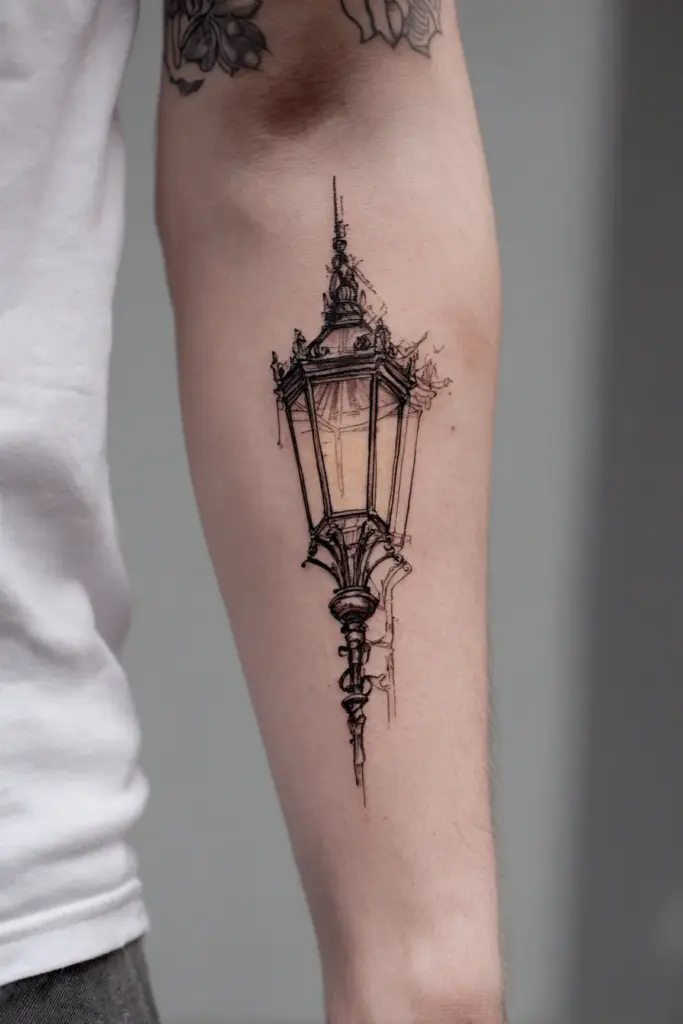Im Hakan, a professional tattoo consultant and designer with over a decade in modern tattoo culture, working across private studios and bespoke commissions. The inner bicep is one of my favorite placements for men: a discreet, curving canvas that flatters script, portraits, geometric compositions and illustrative pieces. This spot suits men who want an intimate design thats easy to hide for work but striking when revealed. In consultations I prioritize flow with musculature, sizing for longevity, realistic pain expectations, and how the piece will age. Practical tips: opt for medium-to-bold lines over micro-detail in high-friction areas, test stencil placement while flexing, expect variable sensitivity near the armpit, and choose an artist experienced with inner-arm healing. Bring clear reference images, plan for possible touch-ups, and follow aftercare strictly to protect linework and color.
Biomechanical Wing Forearm Tattoo — Black & Grey Realism
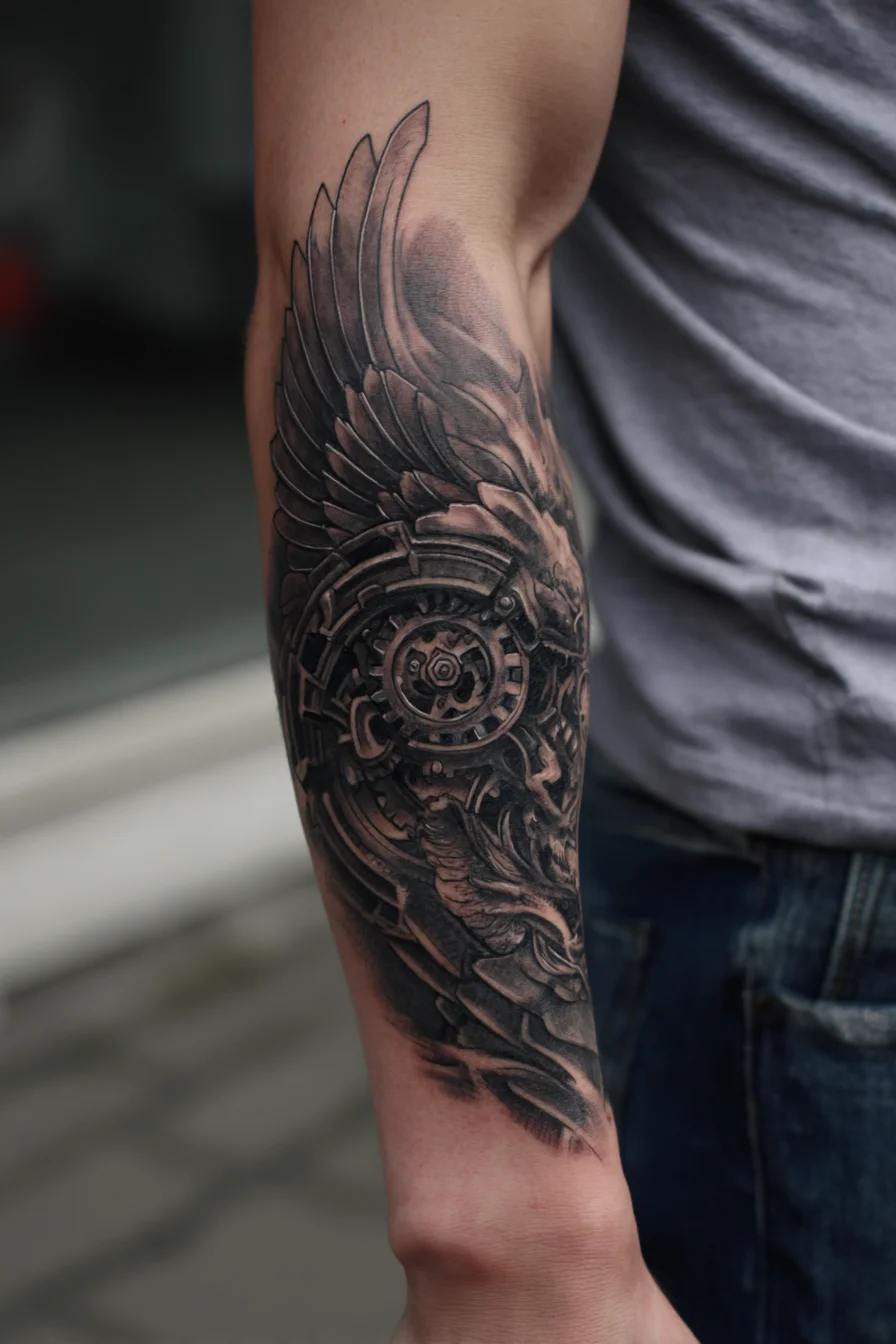
This forearm design blends an angelic wing with mechanical gears to create a biomechanical motif that reads as strength, protection, and the balance between instinct and precision. The wing elements convey freedom and guardianship while the cogs and pistons suggest resilience, discipline, and engineered power. Ideal placement is the outer or inner forearm where the long vertical shape follows natural anatomy; it also adapts well as a half-sleeve that flows into the bicep or chest. Expect moderate pain: the outer forearm is one of the more tolerable locations, while the inner forearm and near the wrist can be more sensitive. For detail retention, choose a medium-to-large size so gears and feather micro-shading remain crisp — typically at least half the forearm length for realism. Styling variations include pure black-and-grey realism (as pictured) for a masculine, timeless look; selective color highlights (metallic blues, bronze or rust tones) to emphasize mechanical parts; high-contrast dotwork or negative-space feathers for a graphic approach; or full-sleeve integration with tribal or script elements. Work with an artist experienced in biomech realism for consistent depth and aging, and plan touch-ups for high-motion areas.
Ornamental Black & Grey Wing/Feather Forearm Tattoo for Men
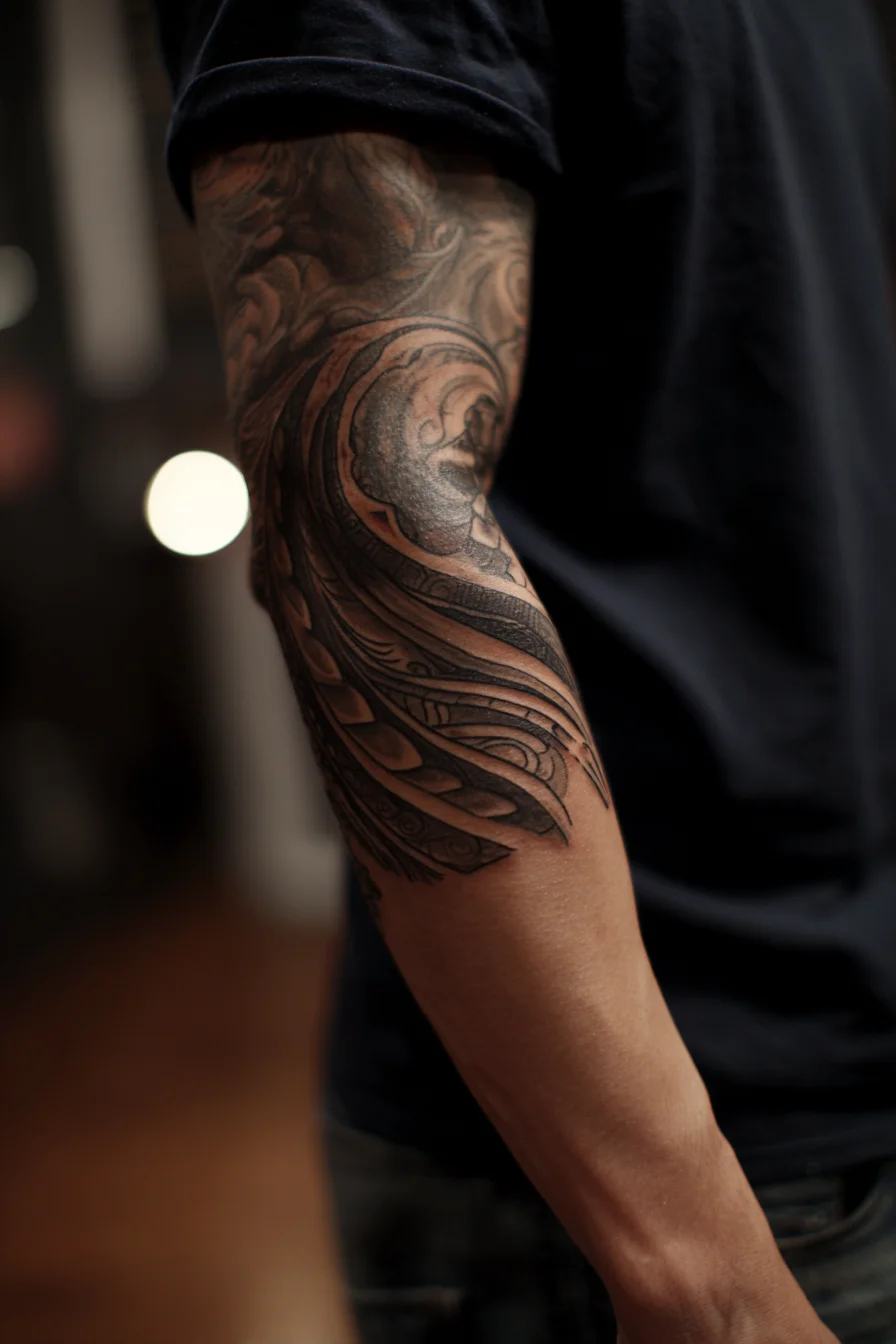
This black-and-grey ornamental wing/feather forearm design uses flowing lines, layered feather textures and negative space to convey motion, protection and resilience. Meaning: wings and feathers often symbolize freedom, personal growth and guardianship — a masculine yet refined choice for a signature arm piece. Placement suggestions: ideal as an outer-forearm half-sleeve, an inner-forearm panel, or wrapped toward the elbow for a connected sleeve; it can also be extended onto the bicep or chest to form a continuous composition. Pain expectations: the outer forearm is moderate in pain and generally well-tolerated during longer sessions; expect increased sensitivity around the inner forearm, wrist and elbow crease where skin is thinner. Size considerations: scale the design up to preserve feather detail and smooth gradations — reducing it too small will cause loss of texture and muddy shading. Styling variations: classic black-and-grey for longevity and contrast, or introduce selective color highlights (teal, rust) for emphasis; consider dotwork fills, geometric insets or tribal linework for a fusion look. Discuss visibility, aftercare and touch-up plans with your artist to match lifestyle and workplace requirements.
Realistic Lion Forearm Tattoo — Black & Grey Lion Portrait
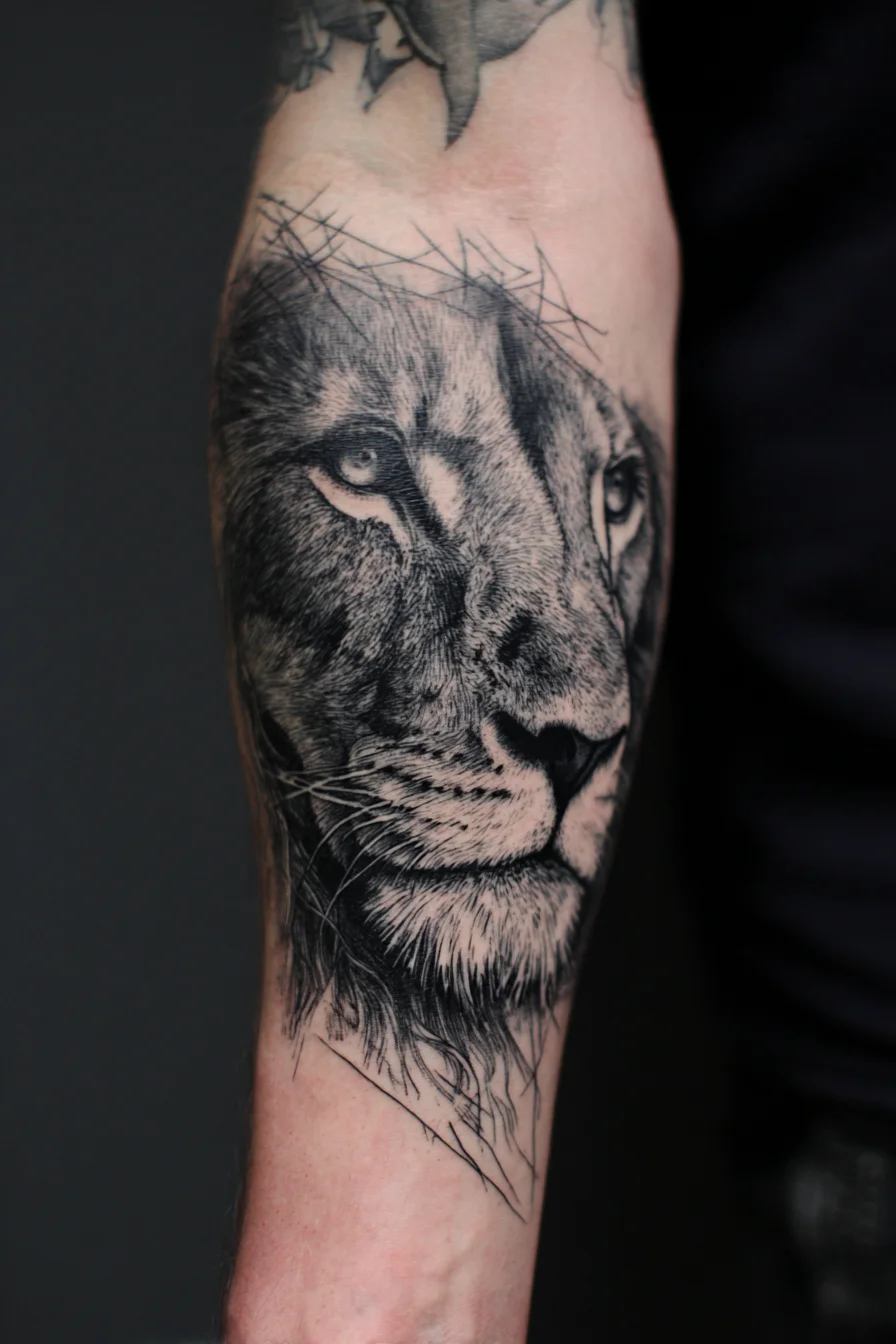
This bold black-and-grey lion portrait reads as strength, leadership and quiet confidence — a classic masculine motif that works well as a statement piece. The high-detail fur, eyes and whisker work communicate maturity and presence; conceptually it suits themes of protection, pride and personal resilience. Placement suggestions: the vertical composition is ideal for the forearm (inner or outer), running from wrist toward elbow, but it also scales to the bicep, chest/sternum or calf for a larger canvas. Pain expectations: forearm placements generally fall in the low-to-moderate range — outer forearm is among the least painful, inner forearm and near bone or elbow areas increase sensitivity. Size considerations: to retain facial detail and texture, aim for a minimum of ~4–6 inches (10–15 cm) tall; for full mane and shading, consider a half-sleeve or larger. Styling variations: preserve realism or introduce geometric frames, dotwork, heavy blackwork, or subtle color highlights in the eyes/mane. Practical tips: choose a fine-line, experienced portrait artist, expect a longer session and potential touch-ups, and follow strict aftercare to maintain contrast and detail.
Baroque Scroll Elbow Tattoo — Ornamental Black & Grey Flourish
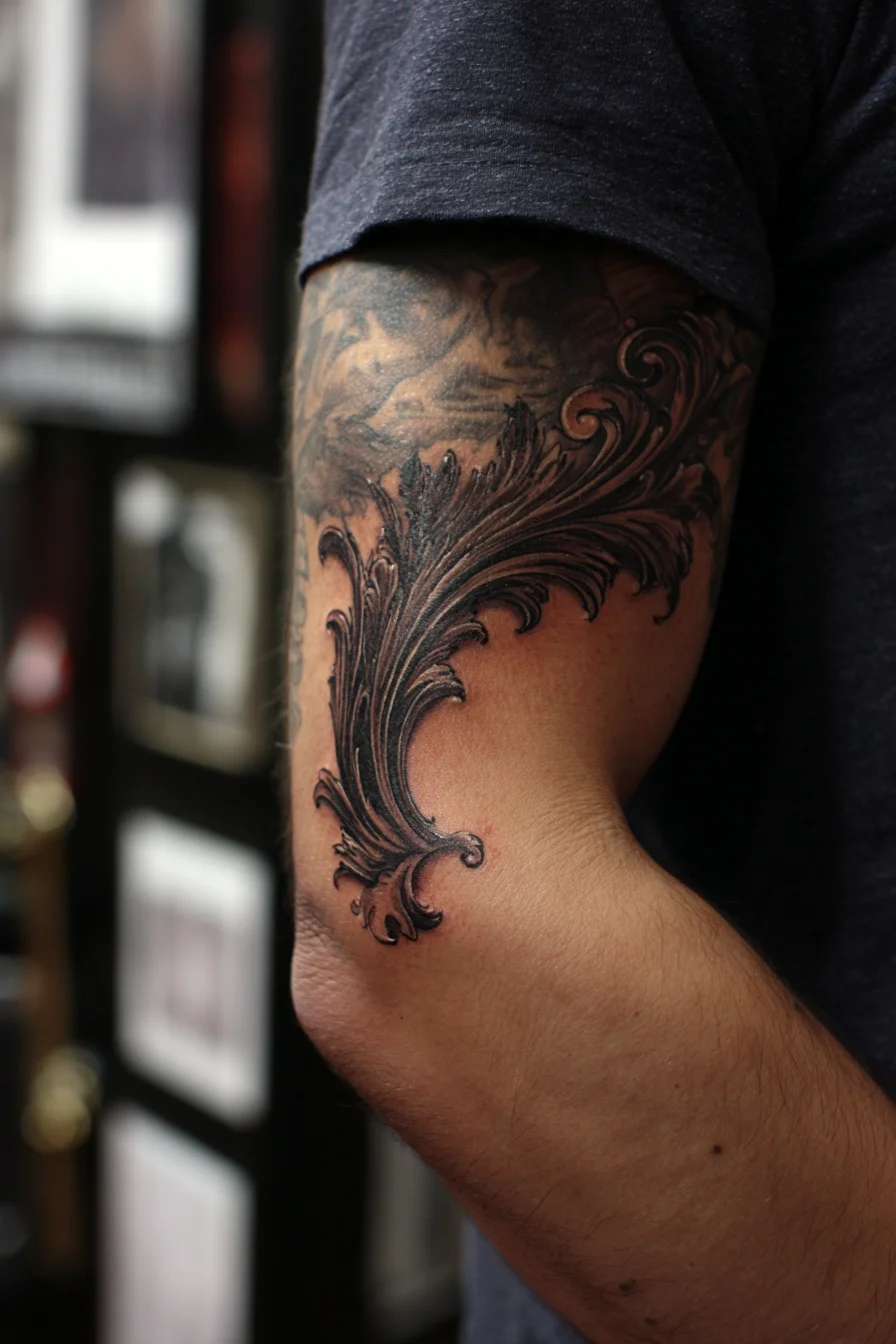
This ornamental baroque-style scroll reads as a dynamic, masculine flourish designed to follow the elbow’s natural curve. Symbolically, acanthus and filigree motifs often convey resilience, heritage and controlled strength — a decorative way to accent muscle and motion without literal imagery. Placement suggestions: position the widest sweep over the elbow crease so the piece moves with the arm; it works well on the outer or inner elbow and can be extended onto the forearm, bicep or become part of a half-sleeve. Pain level expectations: expect moderate to high discomfort around the elbow — the olecranon and inner crease are thin-skinned and bony, so sessions in that area feel sharper; many clients prefer shorter sessions or numbing options. Size considerations: keep the piece medium (roughly 10–15 cm) to preserve fine scroll detail; scaling down loses texture, while enlarging allows seamless integration into sleeves. Styling variations: classic black-and-grey shading, bold blackwork, dotwork backgrounds, white highlights, subtle color accents (deep red or muted gold), or geometric/realistic elements to modernize the look. Consult your artist to map flow lines and joint movement before inking.
Greco-Roman Portrait Forearm Tattoo — Black & Grey Realism
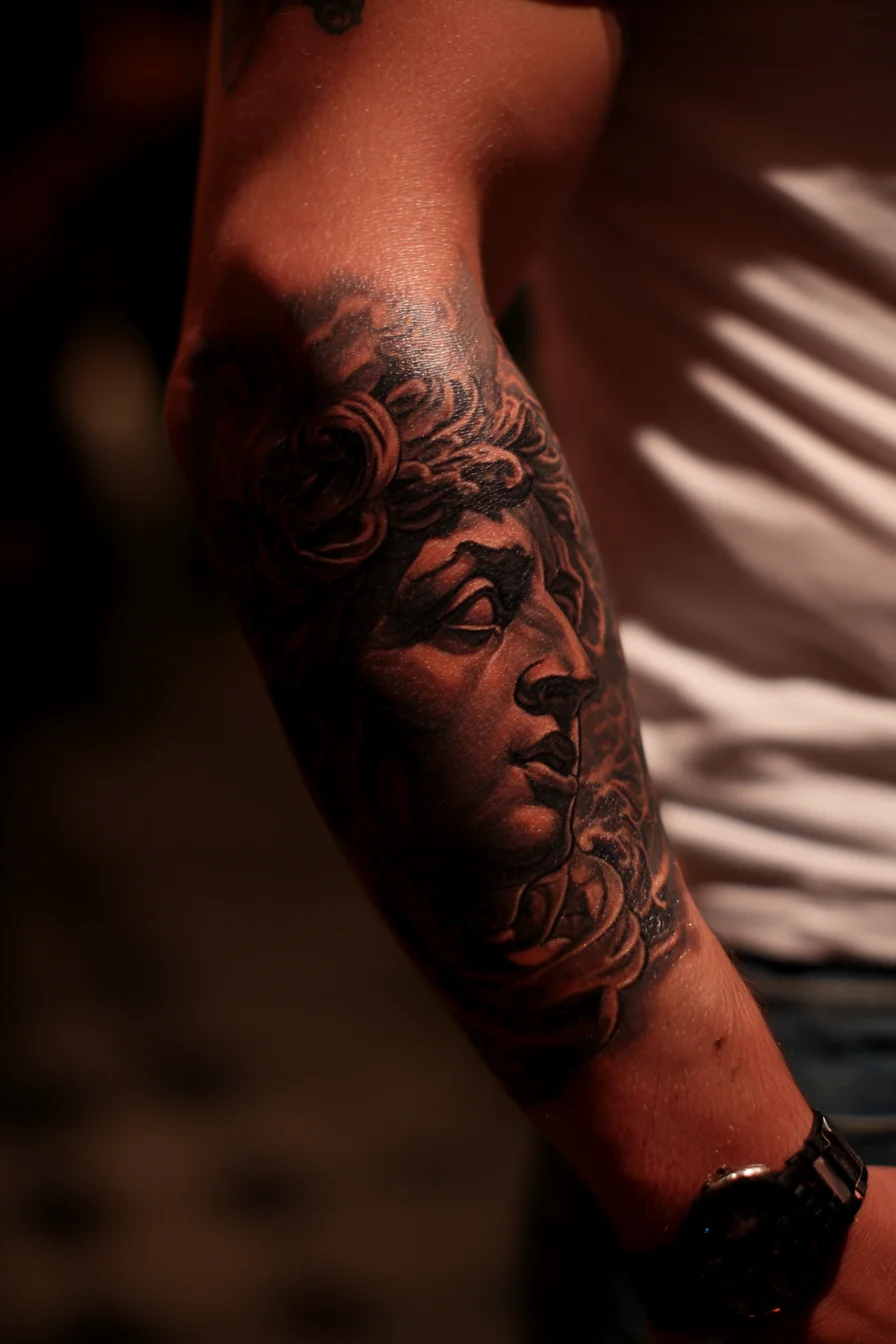
This classical black-and-grey realism forearm tattoo depicts a Greco-Roman sculpted male profile, emphasizing strong chiaroscuro and textured curls. Meaningfully, it evokes timeless strength, stoicism, heritage, and artistic appreciation — ideal for men who want a masculine, cultured statement. Placement: works exceptionally well on the outer or inner forearm, wrapping slightly toward the elbow for natural flow; it also adapts to the upper arm, chest, or calf if you prefer less visibility or want a sleeve. Pain: expect moderate discomfort on the forearm — outer forearm is among the least painful, while areas near the elbow, inner arm, or wrist increase sensitivity; sessions for larger pieces may require breaks. Size: to preserve facial details and smooth shading, plan medium to large dimensions (roughly 15–25 cm / 6–10 in tall); smaller sizes will lose fine features. Styling variations: keep classic black-and-grey realism, or add subtle sepia tones; incorporate laurel wreaths, Roman motifs, geometric backgrounds, script, or clockwork to personalize; consider connecting pieces for a cohesive sleeve. Ask your artist for reference photos and stenciling to ensure accurate placement and contrast.
Vintage Lantern Forearm Tattoo — Fine-Line Blackwork Lamp Design
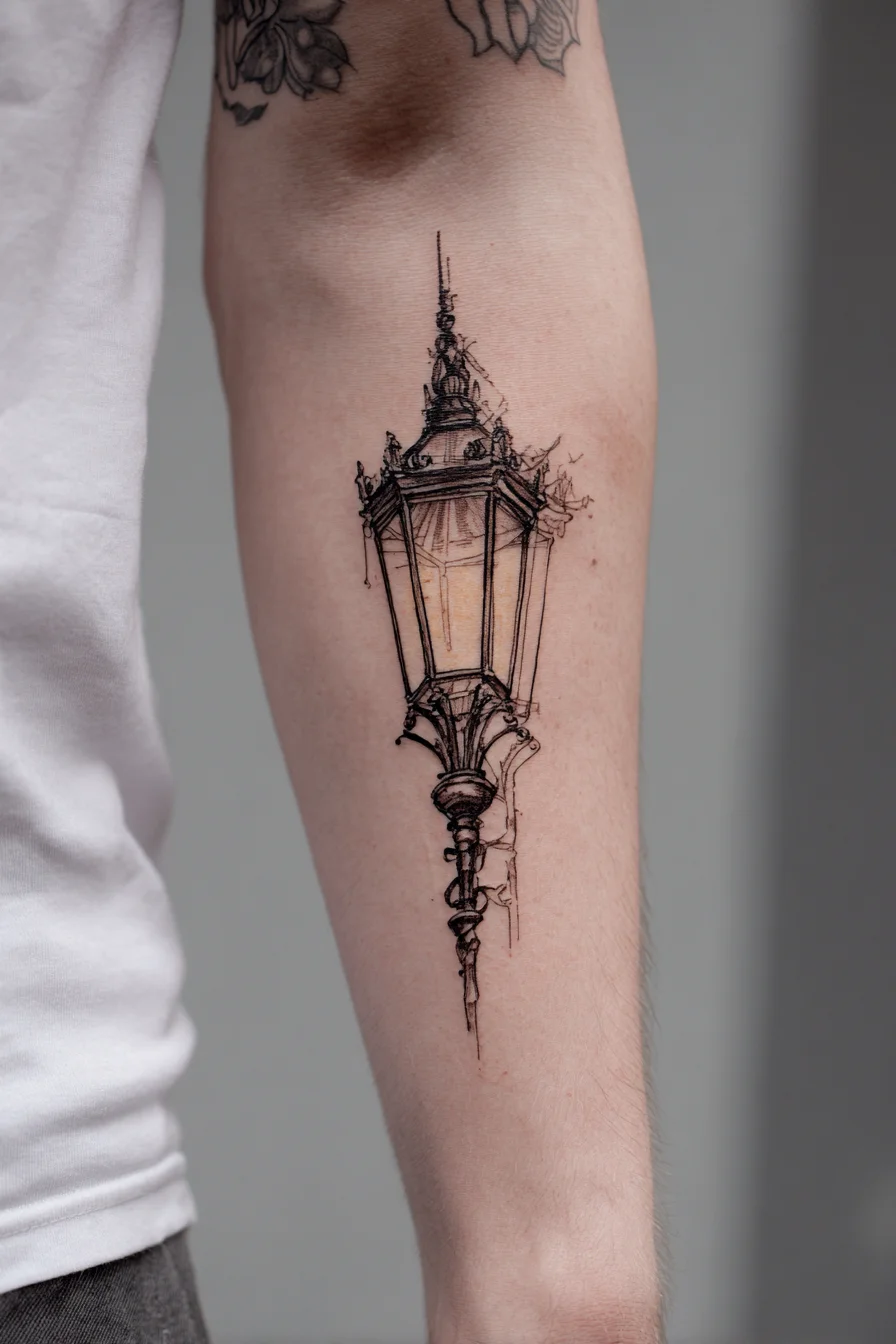
An ornate vintage lantern rendered in fine-line blackwork, this design symbolizes guidance, memory, and an inner light. On the forearm it reads as a vertical statement piece with delicate detailing and a subtle amber glow. Placement: Ideal for the inner or outer forearm because the long, vertical composition fits the arm’s contours; also adapts well to the upper arm, sternum, or along the ribs for a more private placement. For men seeking visibility choose the outer forearm or lower sleeve; for intimacy pick the ribs or chest. Pain: Expect mild to moderate discomfort on the forearm; the inner forearm is slightly more sensitive than the outer. Ribs and sternum will be significantly more painful and may require breaks. Size considerations: To preserve the fine line detail avoid very small scales — aim for a minimum height of 4–6 inches (10–15 cm). Larger sizes allow richer shading and texture without risking ink spread. Styling variations: Solid blackwork for longevity, stippling/dotwork for texture, warm amber watercolor for the lantern glow, or integrate roses, script, or geometric frames. Thickening key outlines improves contrast for men who prefer bolder tattoos.
Realistic Black Ink Eye Tattoo – Forearm Surreal Sketch & Detail
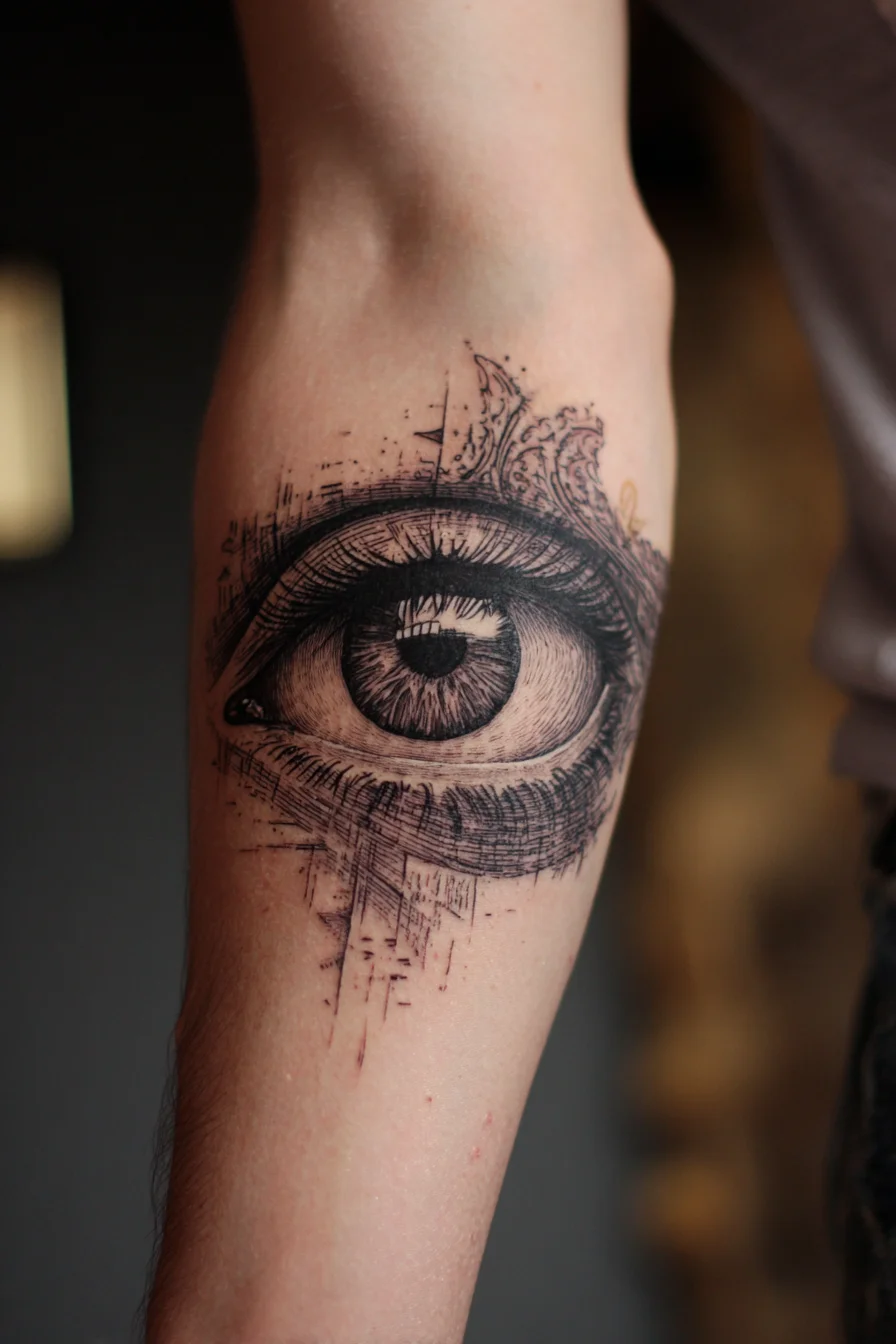
This black-ink eye tattoo combines realistic iris detail with sketch-style hatching and distressed marks, a design that reads as vigilance, inner sight, and personal insight. For men looking for a statement piece, the inner or outer forearm (as pictured) offers visibility and a flat surface that preserves detail; alternative placements include the bicep, chest or calf for a larger, more private piece, while ribs and shoulder provide dramatic options but increase discomfort. Expect low-to-moderate pain on the forearm; areas over bone (wrist, elbow, ribs) are noticeably more intense. To retain the intricate iris and line work, plan for a minimum size of about 4–6 inches (10–15 cm) across — smaller tattoos will lose fine texture and require bolder simplification. Sessions typically run 2–4 hours depending on size and shading; budget a touch-up after healing. Styling variations include pure dotwork, geometric framing, muted color or watercolor splashes for contrast, or added elements like a clock, compass, or filigree. Discuss line weight and longevity with your artist to balance crisp detail and long-term maintenance.
Black & Grey Octopus Forearm Tattoo — Nautical Realism for Men
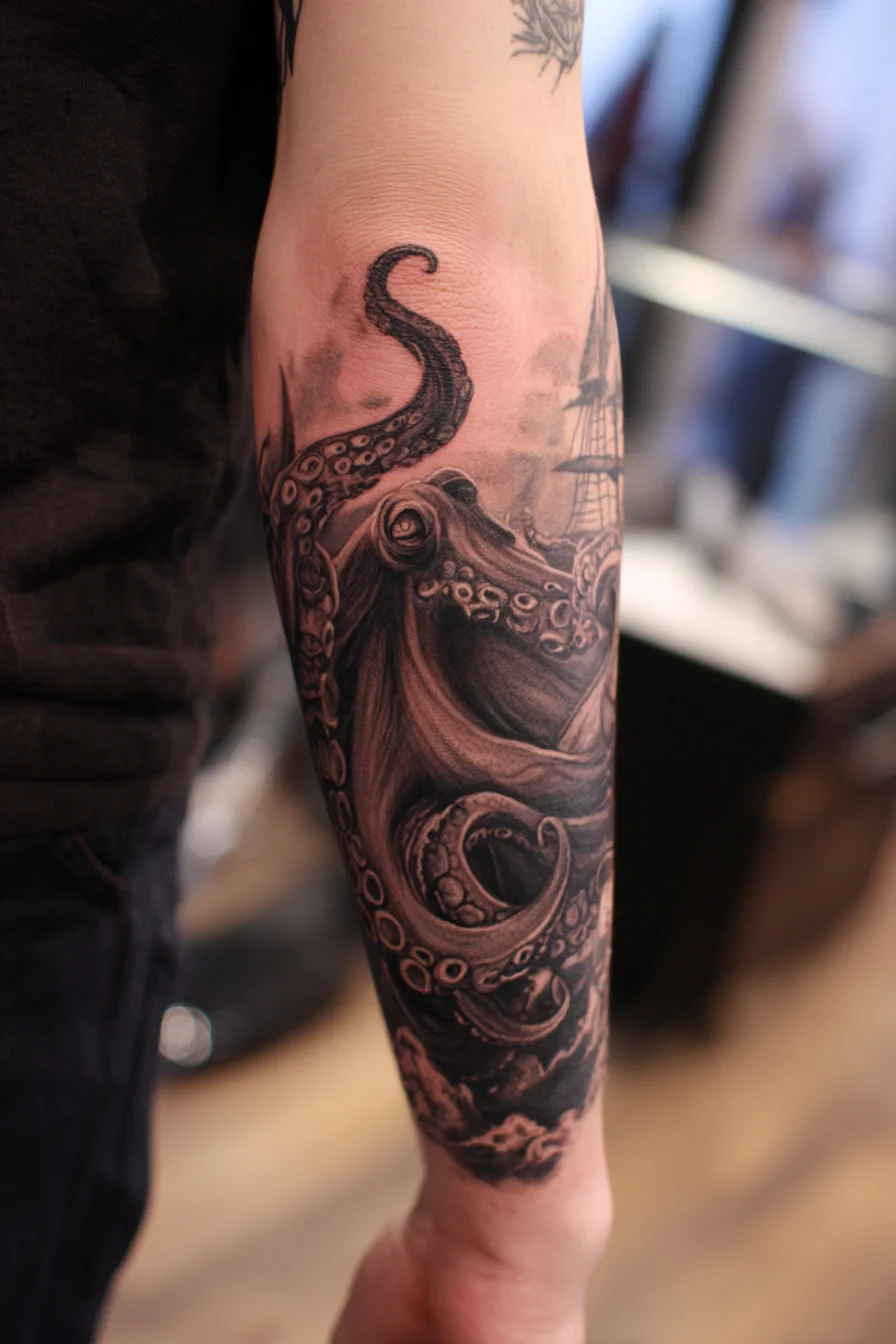
This black-and-grey octopus design reads as a bold nautical realism piece symbolizing adaptability, intelligence, and stealth — classic masculine themes for body art. The flowing tentacles and deep shading create movement and depth, making it ideal for forearm placement where the anatomy enhances the composition. Placement suggestions: outer or inner forearm for visibility and stretch; full forearm or three-quarter sleeve if you want to extend into shoulder, chest, or wrist. Pain expectations: forearm work is generally moderate — outer forearm is one of the least painful spots, while inner forearm near the wrist and elbow can feel more intense. Size considerations: to retain the detailed suckers and textured shading, plan for a medium-to-large piece (6–10 inches); smaller versions will lose fine detail and require bolder, simplified linework. Styling variations: keep it realistic with high-contrast black and grey, add subtle color highlights (navy, teal, red) for accents, or adapt to neo-traditional, dotwork, or geometric interpretations. Discuss session length with your artist — detailed shading often needs multiple sittings for the best result.
Realistic Black & Grey Lion Tattoo — Detailed Arm/Sleeve Design
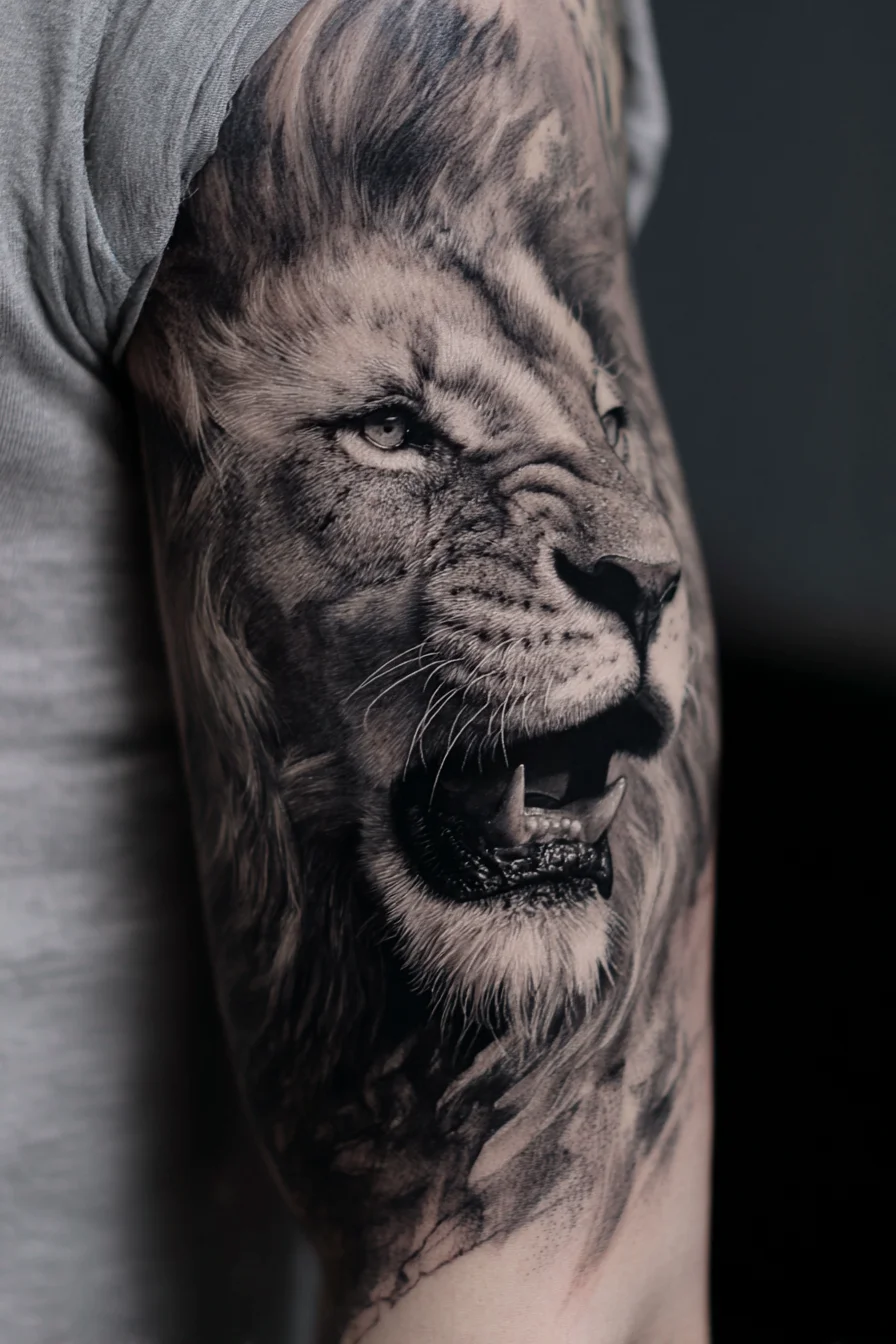
This photorealistic lion head conveys strength, leadership and quiet confidence—qualities often chosen by men who want a bold, timeless piece. The intense gaze and flowing mane read as protection and resilience, making it a strong focal motif for an upper-arm or full-sleeve composition. Placement suggestions: the outer/upper arm or shoulder-to-bicep sleeve best showcase facial detail and follow natural muscle lines; chest, back or calf are alternatives for larger scale. Pain expectations: outer upper arm and shoulder are typically moderate and well-tolerated; inner bicep, elbow, and areas close to bone or thin skin (near wrist or ribs) increase discomfort. Size considerations: realism needs space—plan for a medium-to-large canvas (minimum ~6 inches/15 cm) to preserve fine shading and whisker detail; a full sleeve or half-sleeve allows seamless integration with other elements. Styling variations: keep it classic in black-and-grey realism, or explore dotwork, neo-traditional bold lines, geometric overlays, or subtle watercolor backgrounds. Consider adding complementary symbols (crown, clock, roses or script) to personalize meaning and balance composition.
Realistic Predator Eye Forearm Tattoo — Black & Grey Detail & Ornamental Filigree
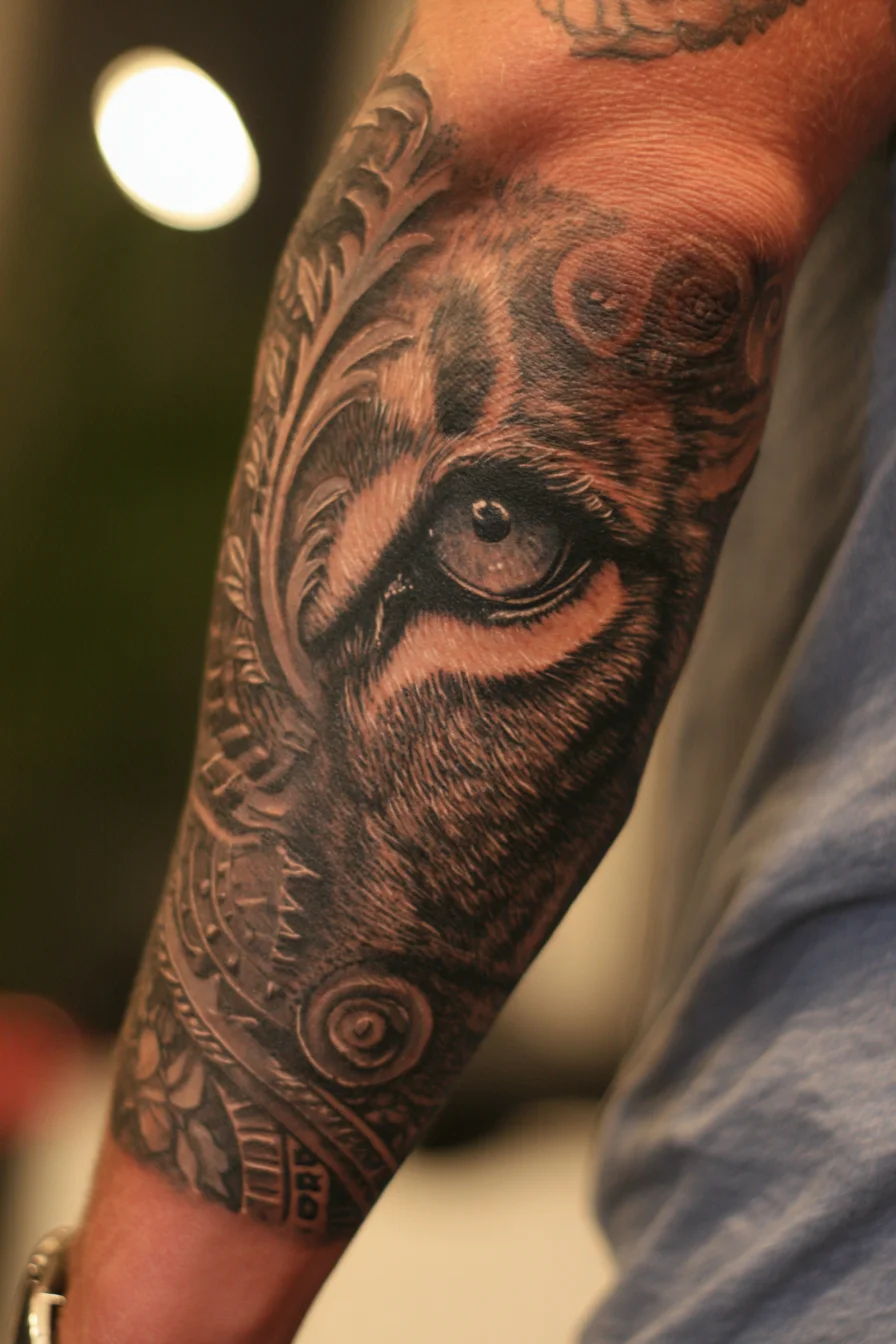
This realistic predator-eye tattoo blends hyper-detailed animal-eye realism with ornamental filigree and dotwork, evoking focus, protection and primal strength. For men wanting a statement piece, the eye reads as vigilance and inner resolve while the surrounding decoration adds personality and balance. Placement suggestions: the outer forearm (as pictured) is ideal for visibility and low distortion; the inner forearm makes the piece more intimate; it also translates well to the biceps, chest or calf and can be expanded into a half- or full-sleeve. Pain expectations: outer forearm sessions are generally low-to-moderate; expect higher sensitivity toward the inner forearm, wrist and around the elbow bone. Size considerations: to keep the eye’s fine texture and reflective highlights, plan for a medium-to-large canvas — roughly 4–6 inches (10–15 cm) minimum; larger sizes improve realism and allow more ornate borders. Styling variations: pure black-and-grey realism, a colored iris accent (blue/amber), geometric or tribal framing, dotwork backgrounds, or neo-traditional bold outlines. Discuss placement, skin type and session pacing with your artist for best long-term results.
Greek Statue Portrait Tattoo — Black & Grey Realism Upper Arm
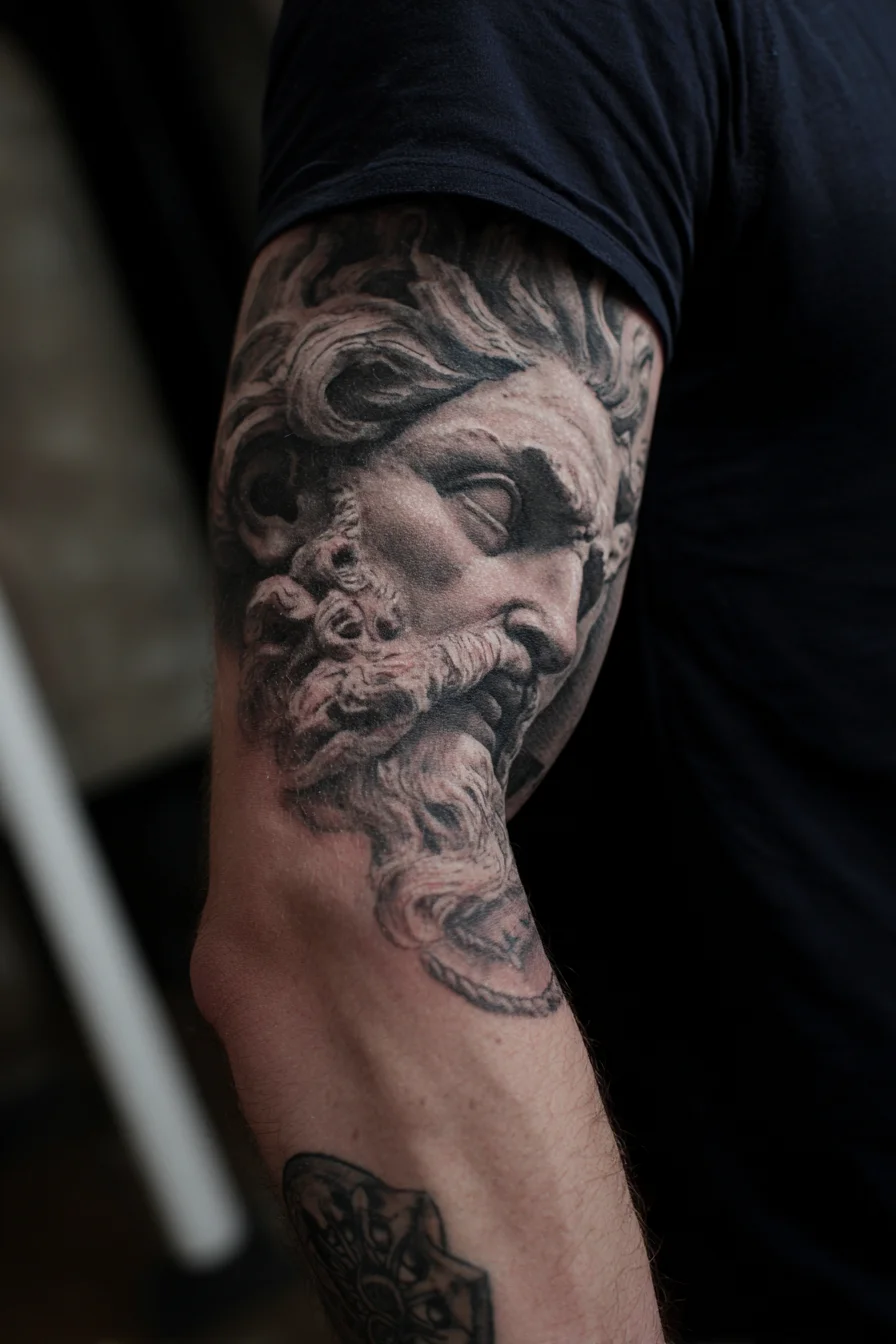
This classical bearded statue portrait reads as a symbol of strength, wisdom and timeless masculinity. Rendered in black-and-grey realism it suits men seeking a bold yet refined piece. Ideal placements are the outer or inner upper arm and bicep as a standalone portrait or as the focal point of a half-sleeve; the design also scales to the chest, shoulder cap or back when expanded. Expect pain to be moderate on the fleshy outer bicep, higher on the inner arm, elbow and where skin sits over bone. Realistic facial detail requires scale — aim for a minimum of 15–20 cm (6–8 in) tall to preserve shading and texture; full half-sleeves or larger panels give the best impact. Plan for multiple sessions for linework, shading and texture. Styling variations include high-contrast black-and-grey realism, engraved/etching textures, geometric backgrounds, dotwork halos, subtle color accents (gold or sepia), laurel wreaths or cracked marble effects. Discuss skin tone, contrast preferences and aftercare with your artist; realistic portraits commonly need a touch-up after healing and diligent sun protection to retain depth.
Realistic Black & Grey Tiger Forearm Tattoo — Masculine Wildlife Portrait
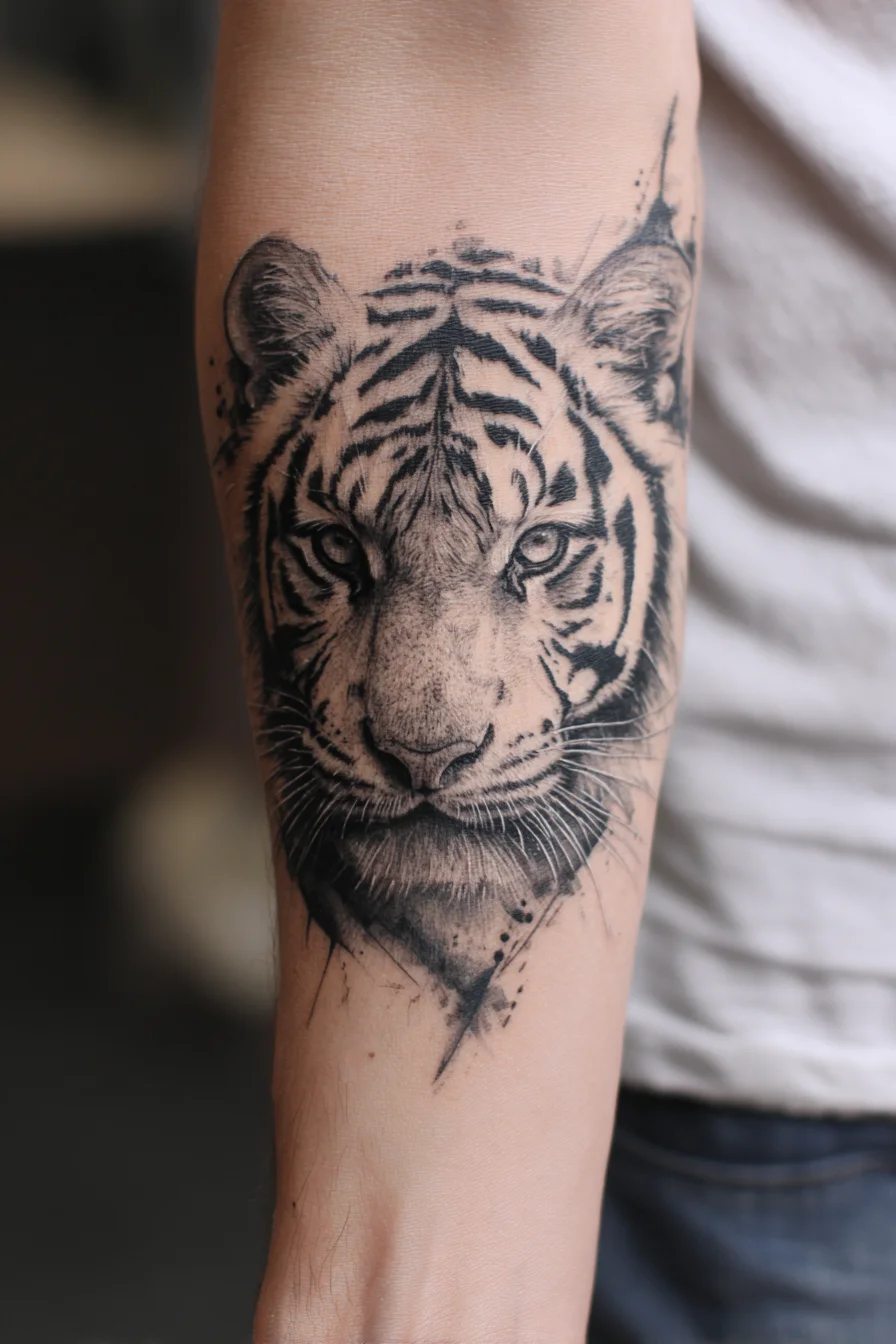
This realistic black and grey tiger head symbolizes strength, focus, and personal resilience — a popular masculine choice that reads bold without shouting. The design’s intense eyes and fine whisker detail convey presence and confidence, making it a strong statement piece for men wanting a meaningful focal tattoo. Placement suggestions: inner or outer forearm (shown), upper arm or calf for similar visibility, or integrated into a half/three-quarter sleeve or chest piece. Pain expectations: forearm work is generally mild-to-moderate; expect more sensitivity near the wrist, elbow and over thin skin. Detailed facial shading takes longer and can feel more intense than broad fill work. Size considerations: to preserve realism, opt for a medium to large scale (roughly 4–8 inches vertical) so eyes and fine textures remain crisp; anything much smaller will lose detail. Styling variations: keep it pure black & grey realism, add dotwork or geometric framing, introduce muted color accents or watercolor splashes, or pair with script or tribal elements for a customized masculine aesthetic. Discuss session length and touch-up plans with your artist for optimal longevity.
Blackwork Coiled Dragon Forearm Tattoo — Strength, Protection, and Movement
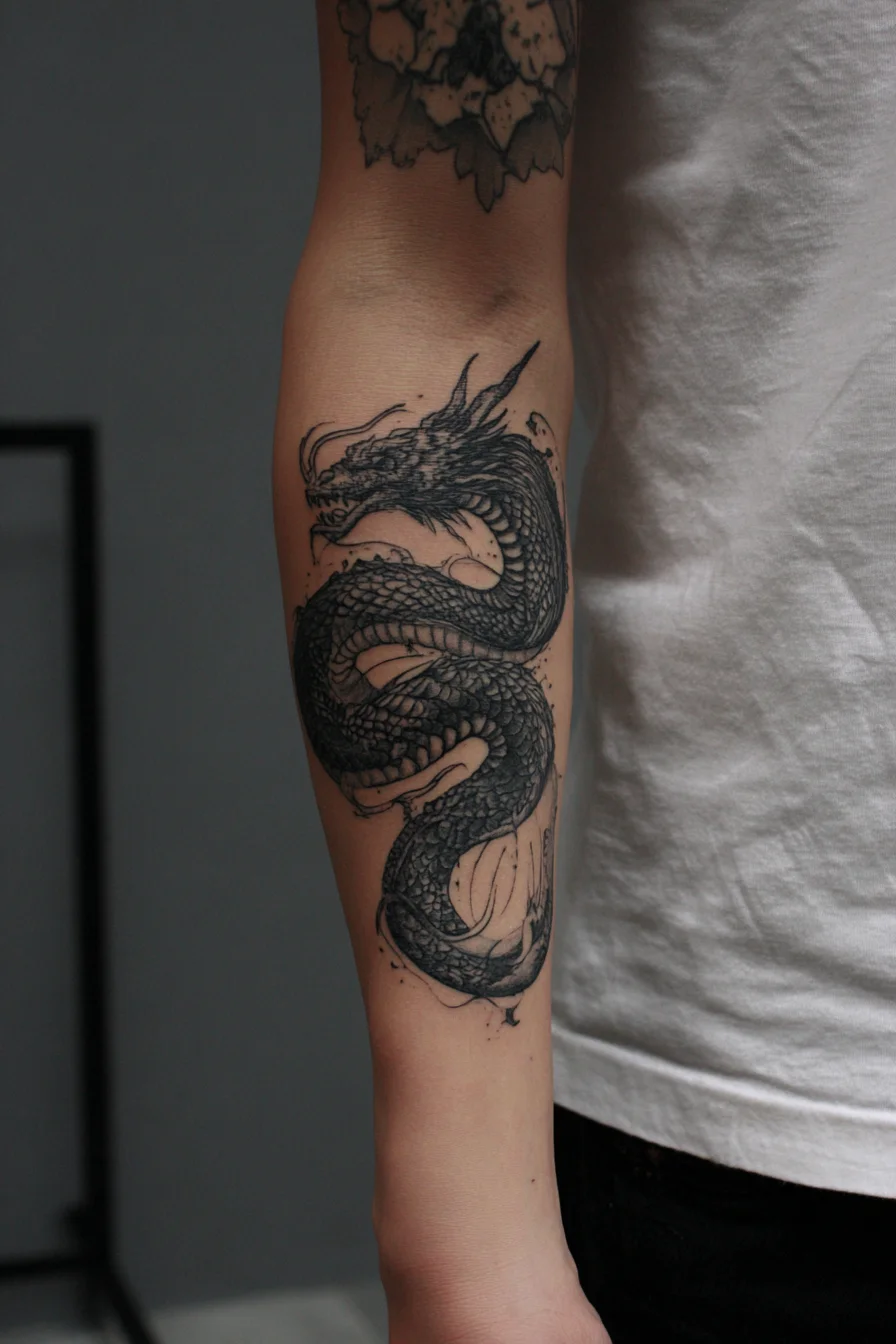
This coiled dragon design reads as a classic symbol of strength, protection, and controlled aggression — ideal for men who want a bold, masculine statement with cultural depth. The vertical, wrapping composition suits the inner or outer forearm, where natural musculature accentuates the dragon’s curves; it also adapts well to the upper arm, calf or as part of a half- or full-sleeve. Expect a low-to-moderate pain level on the outer forearm and slightly higher on the inner forearm and near the elbow; dense black shading and heavy linework increase session length and sensitivity. For sizing, keep the piece long enough to follow the forearm’s length (roughly 6–10 inches/15–25 cm) to preserve scale and scale detail; shrinking it much smaller will lose texture in the scales. Styling variations include bold blackwork (high contrast and longevity), fine-line or dotwork for a subtler look, traditional Japanese color and wave backgrounds, or adding realistic shading for a 3D effect. Discuss session breakdown and aftercare with your artist — multiple sittings are common when heavy shading and crisp lines are required.
Forearm Compass & World Map Tattoo — Blackwork Navigation Design
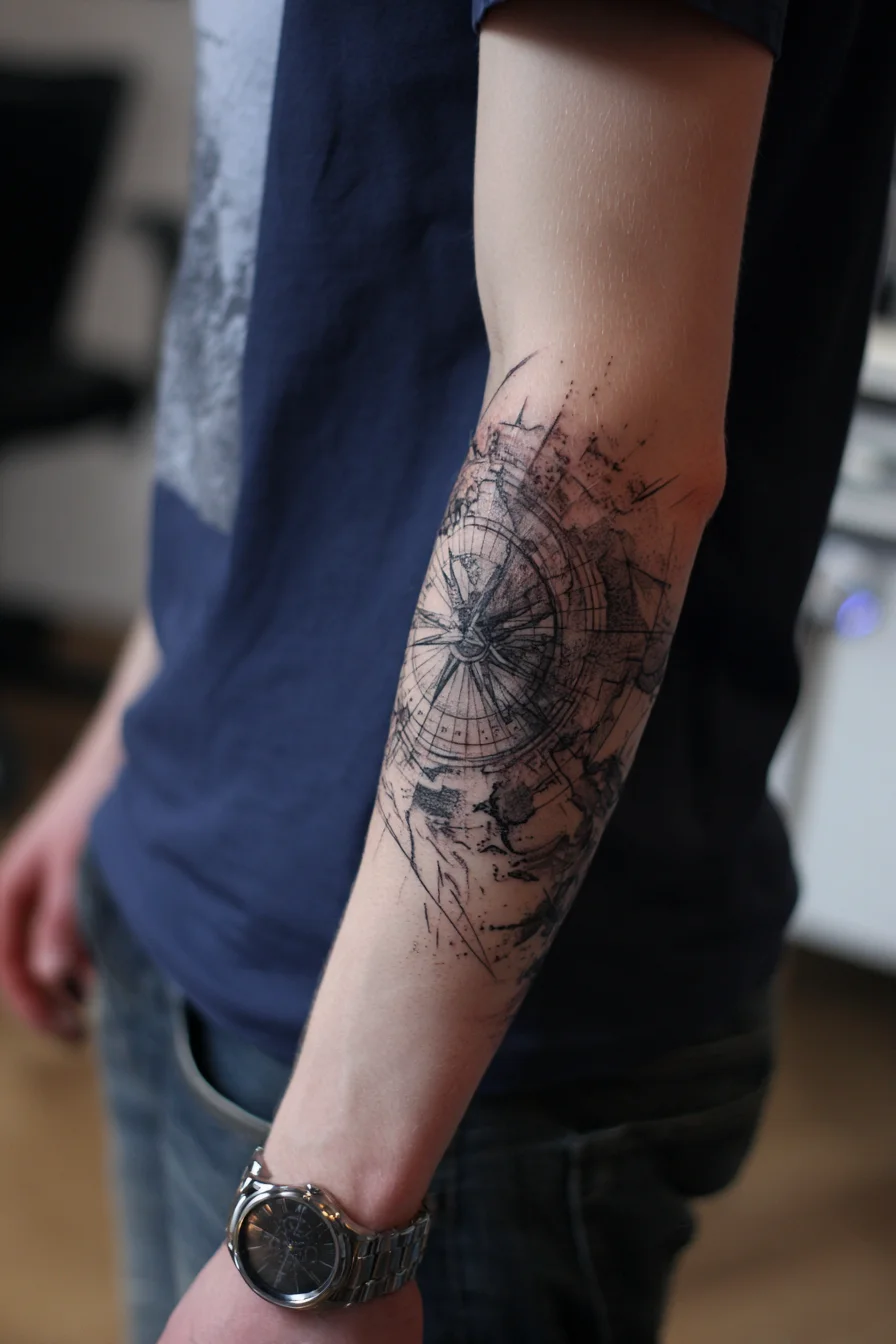
This compass-and-map forearm tattoo symbolizes direction, exploration and personal journey — a strong, masculine motif that works well as a standalone piece or as the foundation of a sleeve. Placement: the outer or inner forearm offers clear visibility and mid-level pain; wrapping the design slightly toward the elbow or wrist creates dynamic movement and allows easy integration with shoulder or bicep pieces. Pain expectations: forearm tattoos are generally moderate in discomfort — outer forearm is among the least painful areas, while the inner forearm and near the elbow can feel more sensitive. Size considerations: for crisp compass detail and map texture choose a medium-to-large size (roughly 6–15 cm) so fine lines and dotwork remain legible over time; very small versions will lose detail and blur faster. Styling variations: blackwork and fine-line dotwork emphasize vintage cartography, while bolder linework or selective color accents (teal, burnt orange) can modernize the look. Discuss line thickness, shading density, and future expansion with your artist to preserve contrast and aging.
Compass & World-Map Forearm Tattoo — Navigation, Travel, Direction
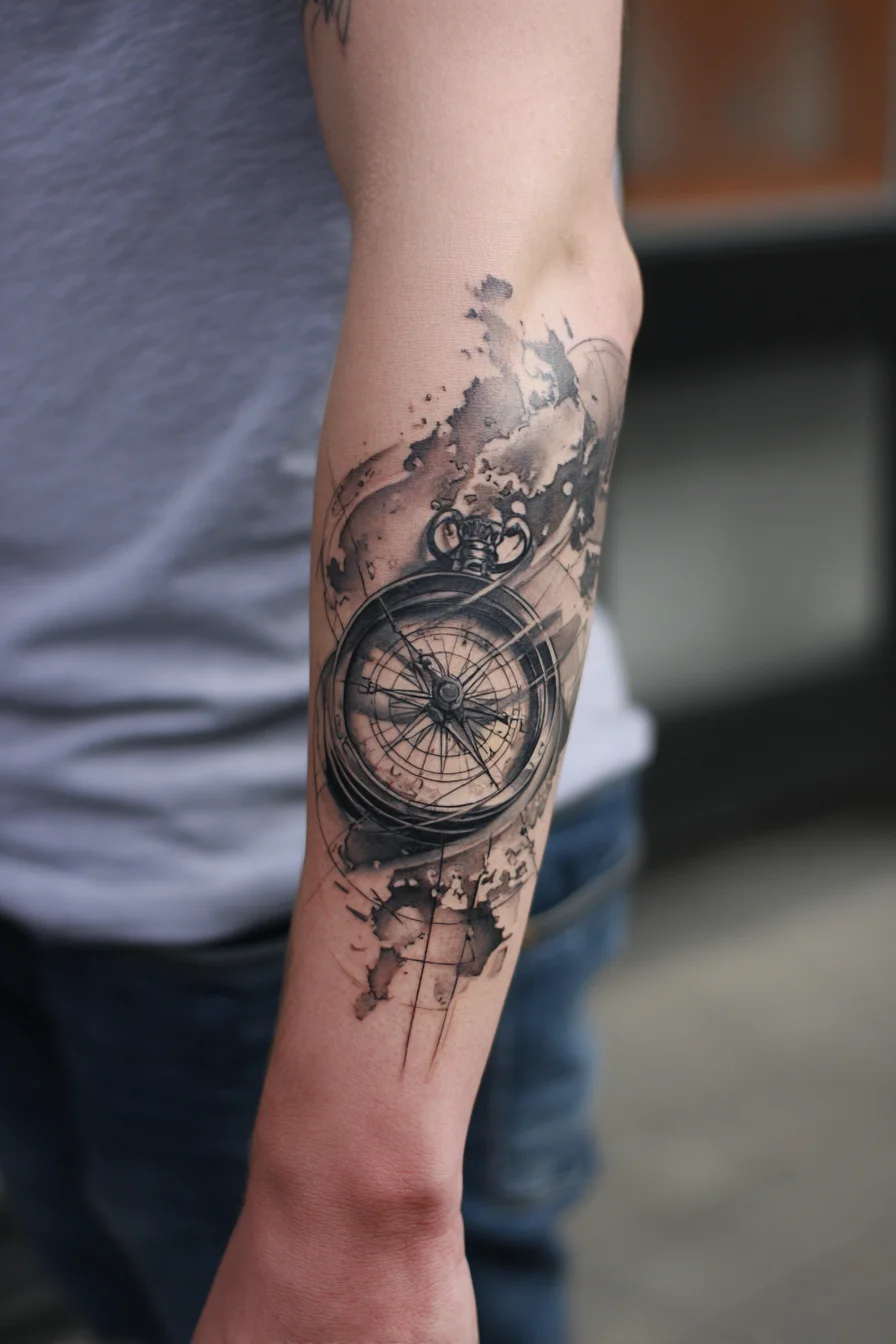
This black-and-grey compass over a watercolor-style world map reads as a masculine emblem of navigation, travel and personal direction. The compass itself symbolizes guidance, values and decision-making, while the globe backdrop ties the design to exploration, roots and life’s journeys. Placement suggestions: outer forearm (as pictured) for visibility and lower pain, inner forearm for a more intimate piece, or upper arm, shoulder blade, chest or calf if you want a larger canvas. Pain expectations: outer forearm and upper arm are low-to-moderate; inner forearm and chest/rib areas are more sensitive; ribs and spine are high. Size considerations: preserve the compass details by keeping the dial at least 10–12 cm (4–5 in) across — smaller sizes risk loss of fine linework over time. Ask your artist for slightly bolder primary lines and adequate spacing to maintain clarity. Styling variations: full black-and-grey realism, watercolor splashes for contrast, dotwork or geometric compass roses, or added elements like coordinates, dates or a pocket-watch motif for personal meaning. Discuss aftercare and future touch-ups with your artist to keep the piece crisp.
Black‑and‑Grey Pocket Watch with Flying Bird — Forearm Realism Tattoo
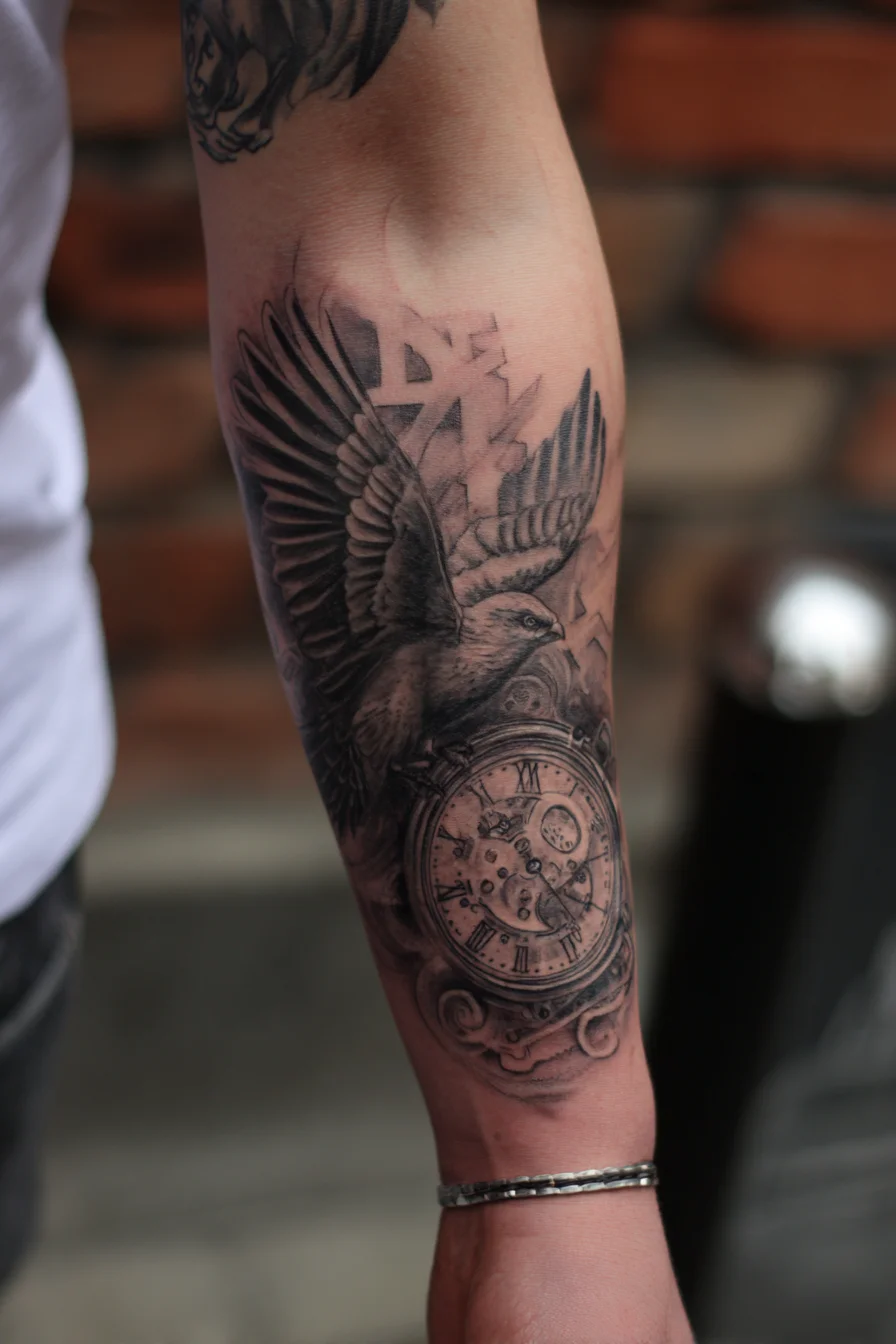
This black‑and‑grey composition pairs a detailed pocket watch with a soaring bird to communicate themes of time, memory and freedom—ideal for men who want a masculine yet reflective piece. The pocket watch anchors the design with mechanical detail and Roman numerals, while the bird adds motion and a sense of escape or renewal. Placement: the inner or outer forearm shown here is perfect for visibility and elongation; it also works wrapped into a half sleeve or along the biceps for continuity. Pain expectations: forearm skin is medium sensitivity—expect moderate discomfort, with increased tenderness near the wrist, inner elbow and over bony areas. Size considerations: to preserve the watch’s fine gears and the bird’s feather work, plan a medium‑to‑large layout that spans most of the forearm; smaller versions will lose crisp detail. Styling variations: keep it realistic black and grey for a classic look, add selective color (gold on the watch or subtle blue in the bird) for contrast, or incorporate script dates, dotwork backgrounds or geometric frames to personalize. Discuss line weight and shading with your artist to ensure longevity and legibility.
Realistic Stag Warrior Upper-Arm Tattoo — Deer Head, Antlers, Muscular Torso
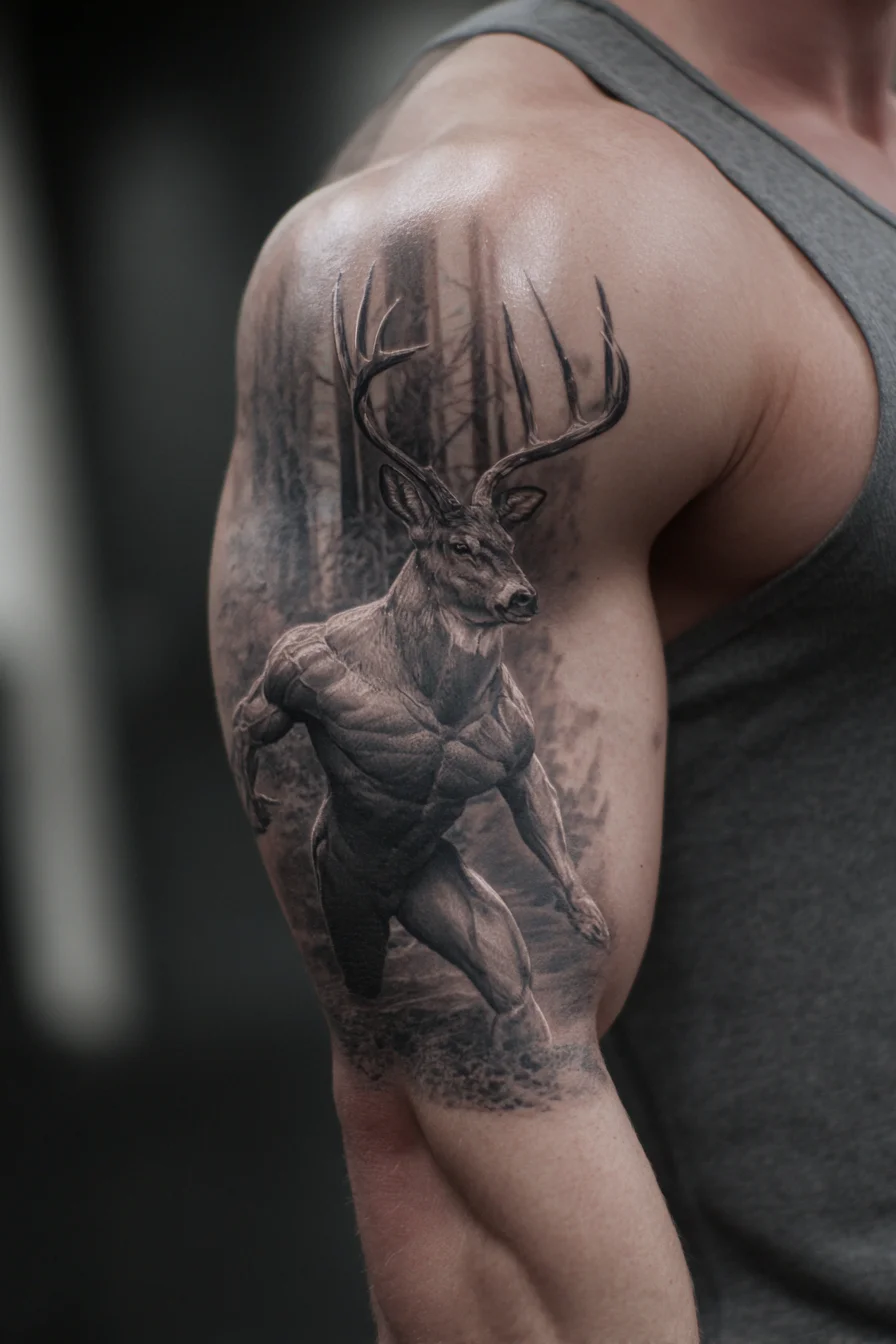
This black-and-grey realistic stag-warrior design marries a deer’s head and sweeping antlers with a highly defined human torso, communicating strength, primal instinct, and protective leadership. It’s a bold, masculine piece that reads as both mythic and natural—great for men who want a statement about resilience, dominance, or rootedness in nature. Placement suggestions: outer shoulder and upper bicep as shown for a clean, visible canvas; extend into a half- or full-sleeve to wrap antlers and forest background across the chest or back. Pain expectations: outer upper arm and shoulder are moderate in discomfort and heal reliably; inner bicep, armpit, ribs, and near bone structures increase sensitivity and pain. Size considerations: detailed realism needs room—plan for a medium to large piece (roughly 6–12 inches/15–30 cm) so musculature, fur texture, and fine antler points stay crisp. Styling variations: pure black-and-grey realism for depth; neo-traditional or muted color washes for impact; dotwork or geometric backgrounds for contrast; or negative-space elements and script to personalize. Expect multiple sessions for shading and fine detail and consult an artist experienced in realism for best results.
Sailing Ship with Anchor Tattoo — Nautical Blackwork Upper-Arm Design
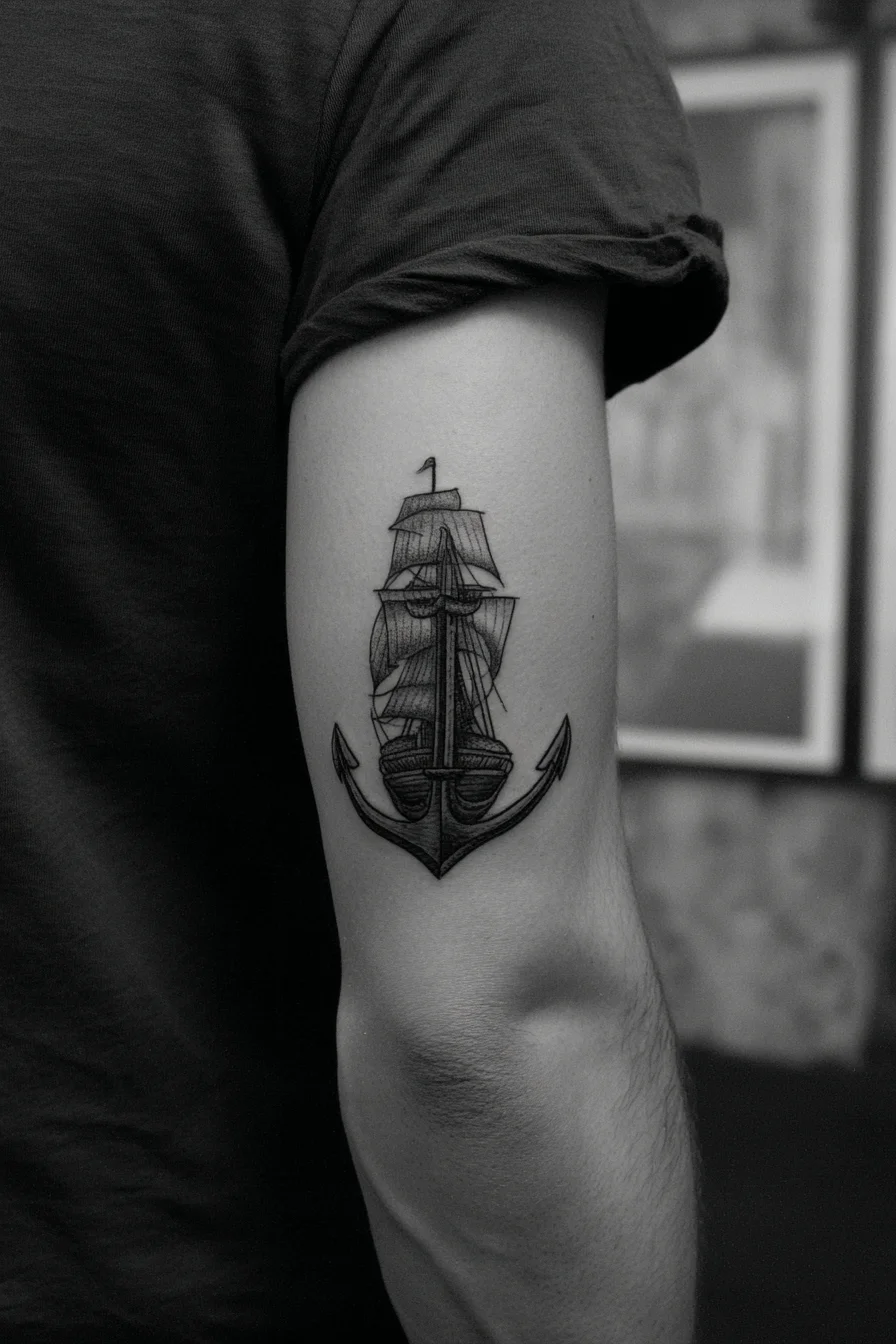
This design fuses a classic tall ship and anchor to symbolize steady leadership, personal journeys, and resilience — an archetypal nautical motif that reads well on men who want meaningful yet masculine body art. The photo shows the piece on the outer upper arm/triceps, which is an excellent natural canvas for its vertical composition. Placement suggestions: outer upper arm for lower pain and easy concealment; inner forearm or sleeve integration for visibility; chest, shoulder blade or calf for larger-scale versions. Pain expectations: outer upper arm is generally low to moderate in discomfort; inner bicep, near bone (elbow, ribs, sternum) or thin-skinned areas will be noticeably tougher. Size considerations: to preserve the ship’s rigging and anchor detail aim for a medium to large vertical size (roughly 10–15 cm / 4–6 in or larger). Smaller reductions risk losing fine-line texture. Styling variations: stick with fine-line blackwork and dot shading for a refined look, or opt for bolder American-traditional outlines, grayscale realism, or selective color accents (navy, rust) and background elements (waves, compass, banners). Discuss needle groupings and touch-up planning with your artist to ensure crisp lines and long-term durability.
Realistic Tiger Forearm Tattoo with Feathers — Blackwork Masculine Design
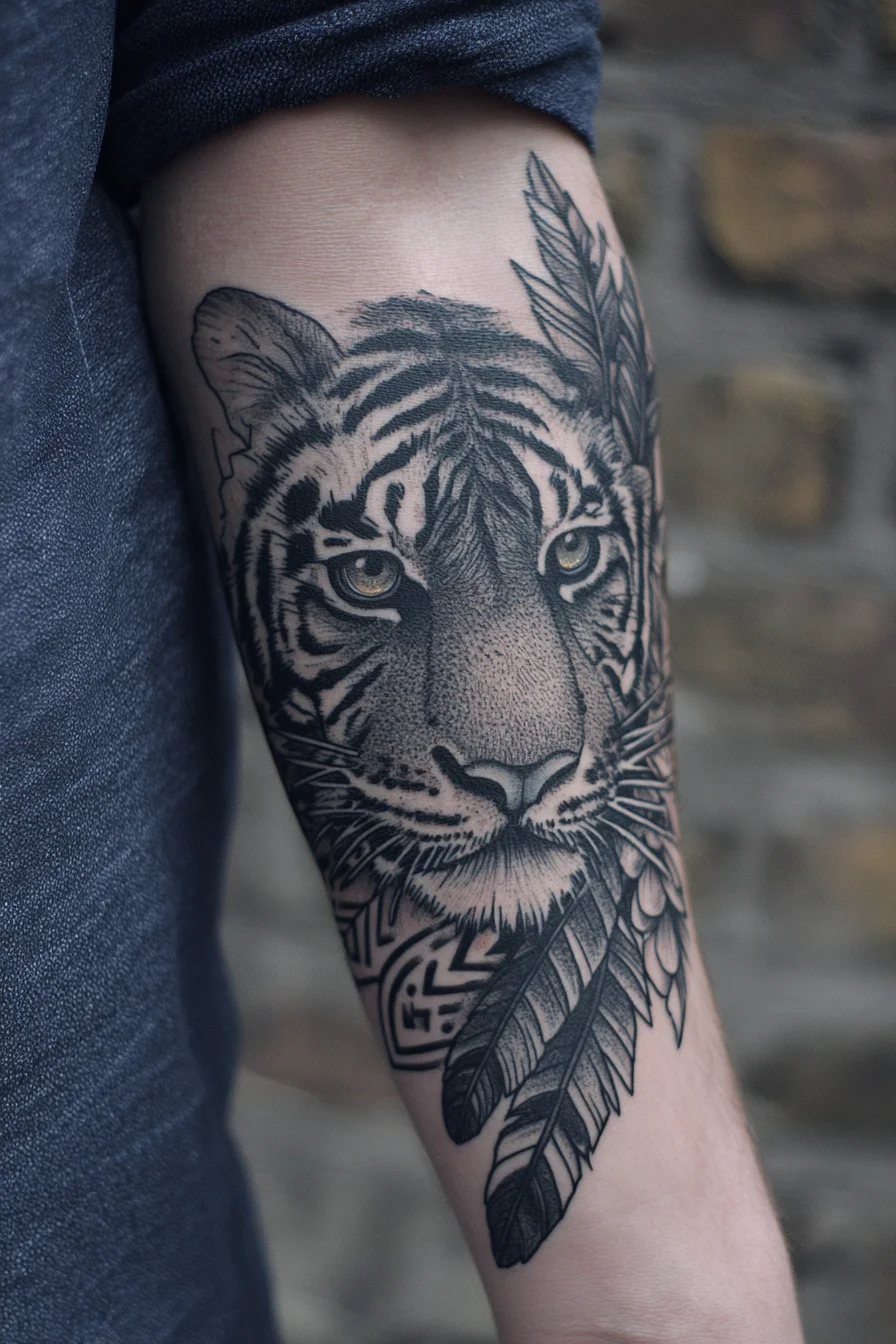
This realistic blackwork tiger head with feathers is a bold masculine forearm piece that symbolizes strength, focus, and protection. The lifelike eyes and fine dot-shading create depth, while the feathers add balance and cultural or spiritual nuance depending on personal meaning. Placement: ideal on the outer or inner forearm — outer forearm showcases the portrait and is easier to display; inner forearm offers a more personal placement with slightly higher sensitivity. Pain: expect low–moderate discomfort on the fleshy forearm; areas near the wrist or elbow will be noticeably more sensitive. Size: choose medium to large (about 4–8 inches / 10–20 cm) to retain facial detail and feather texture; smaller versions risk losing fine linework and stippling. Styling variations: stick with black-and-grey realism, switch to high-contrast blackwork for a graphic look, or add selective color to the eyes or feathers as a focal pop. Practical notes: plan for 1–3 sessions depending on detail, anticipate occasional touch-ups over years, and follow standard aftercare to preserve crisp detail.
Black‑and‑Grey Bearded God Portrait — Upper Arm Masculine Tattoo
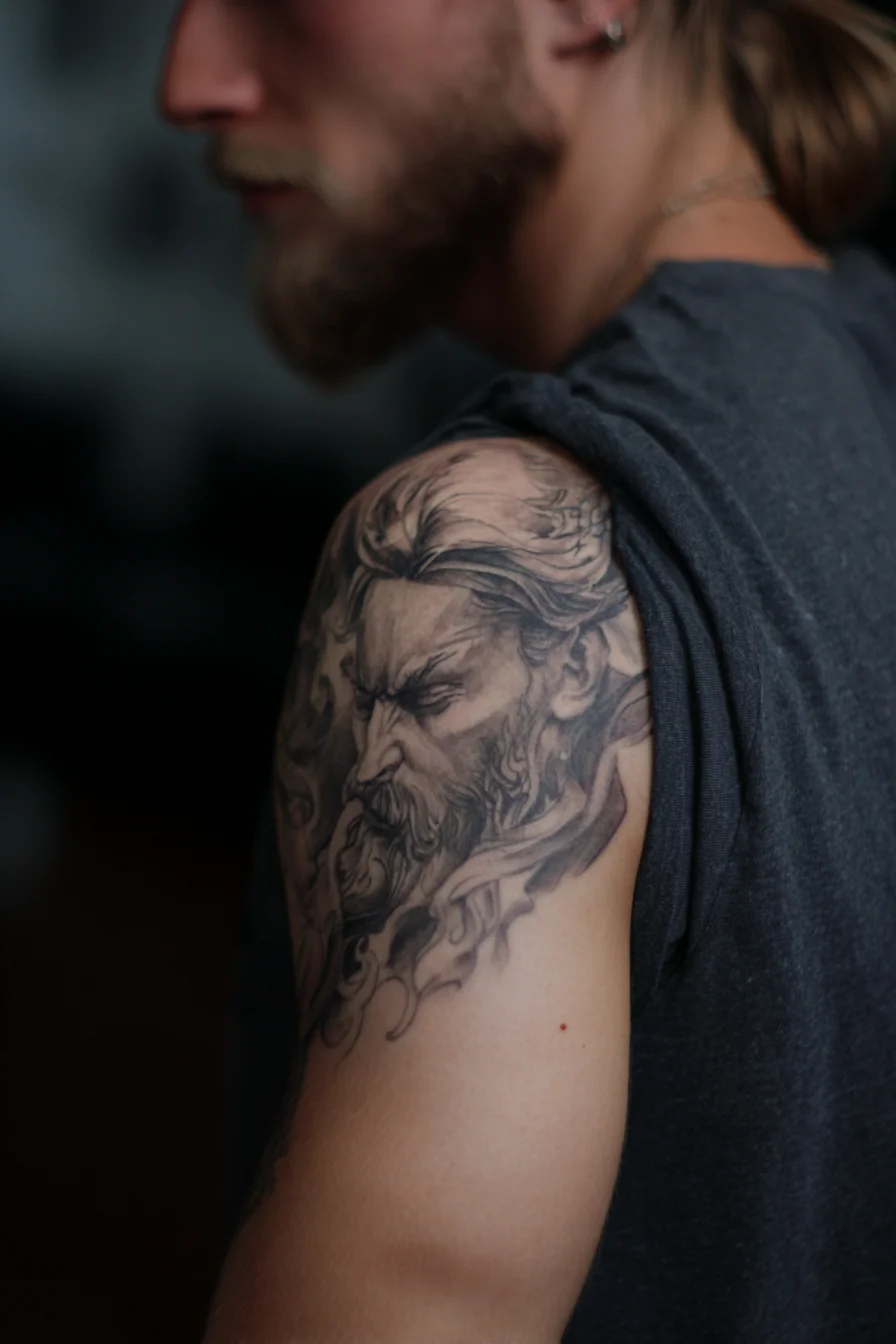
This black-and-grey portrait of a bearded god or warrior conveys themes of strength, wisdom and stoic protection — a classic masculine statement that works well as a focal piece. Placement: the outer shoulder and upper arm suit the composition shown, allowing natural curvature to enhance the face and flowing hair; it also transitions smoothly into a half- or full-sleeve, chest panel or upper-back extension. Pain expectations: the outer deltoid is one of the more forgiving spots (low–moderate pain) while the inner bicep, armpit and collarbone regions will be noticeably more sensitive. Size considerations: portraits need scale to retain detail — aim for mid to large dimensions (roughly 6–10 inches / 15–25 cm) so facial shading and linework remain crisp over time. Styling variations: keep it realistic black-and-grey for a timeless look, or add neo-traditional outlines for bold contrast; introduce subtle color washes (blue or bronze) to suggest sea or lightning themes; consider background elements (clouds, waves, geometric frames) to anchor the piece. Ask your artist about reference placement and session breakdown for optimal healing and longevity.
Japanese Oni Demon Blackwork Tattoo — Upper Arm / Outer Elbow Placement
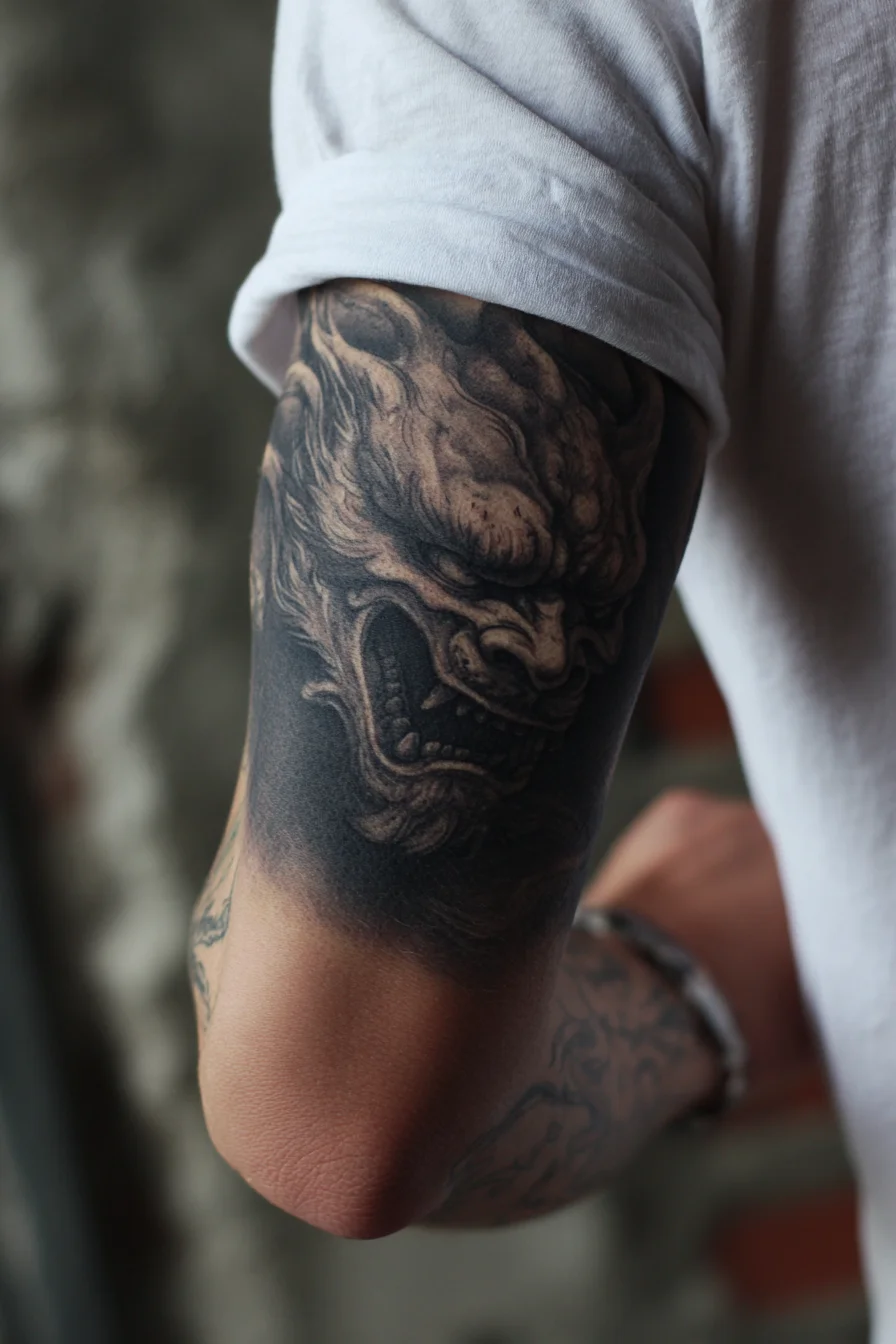
This dark, highly shaded Oni (demon) head makes a strong statement about protection, inner struggle and transformation—traditional themes in Japanese tattooing that work well as masculine symbols. For placement, the upper outer arm or just above the elbow is ideal: it shows off the face’s aggressive features while allowing easy concealment under a sleeve when needed. Expect moderate pain on the outer bicep; pain increases closer to the elbow and inner-arm creases where the skin is thinner and closer to bone. Size matters for detail—plan a medium-to-large artwork (about 15–20 cm / 6–8 in tall) so the teeth, wrinkles and heavy shading read clearly over time. Large pieces often require 1–3 sessions depending on complexity. Styling variations include traditional Japanese color with bold outlines, monochrome blackwork or realistic grayscale for a gritty look, or neo-traditional lines with selective color highlights. Discuss contrast, negative space and how it will age with your artist; heavy black fills heal reliably but need touch-ups in high-sun areas. Bring reference images and be prepared to adjust scale for muscle curvature and long-term visibility.
Black & Grey Realism Sleeve — Pocket Watch, Classical Figure & Dagger Tattoo
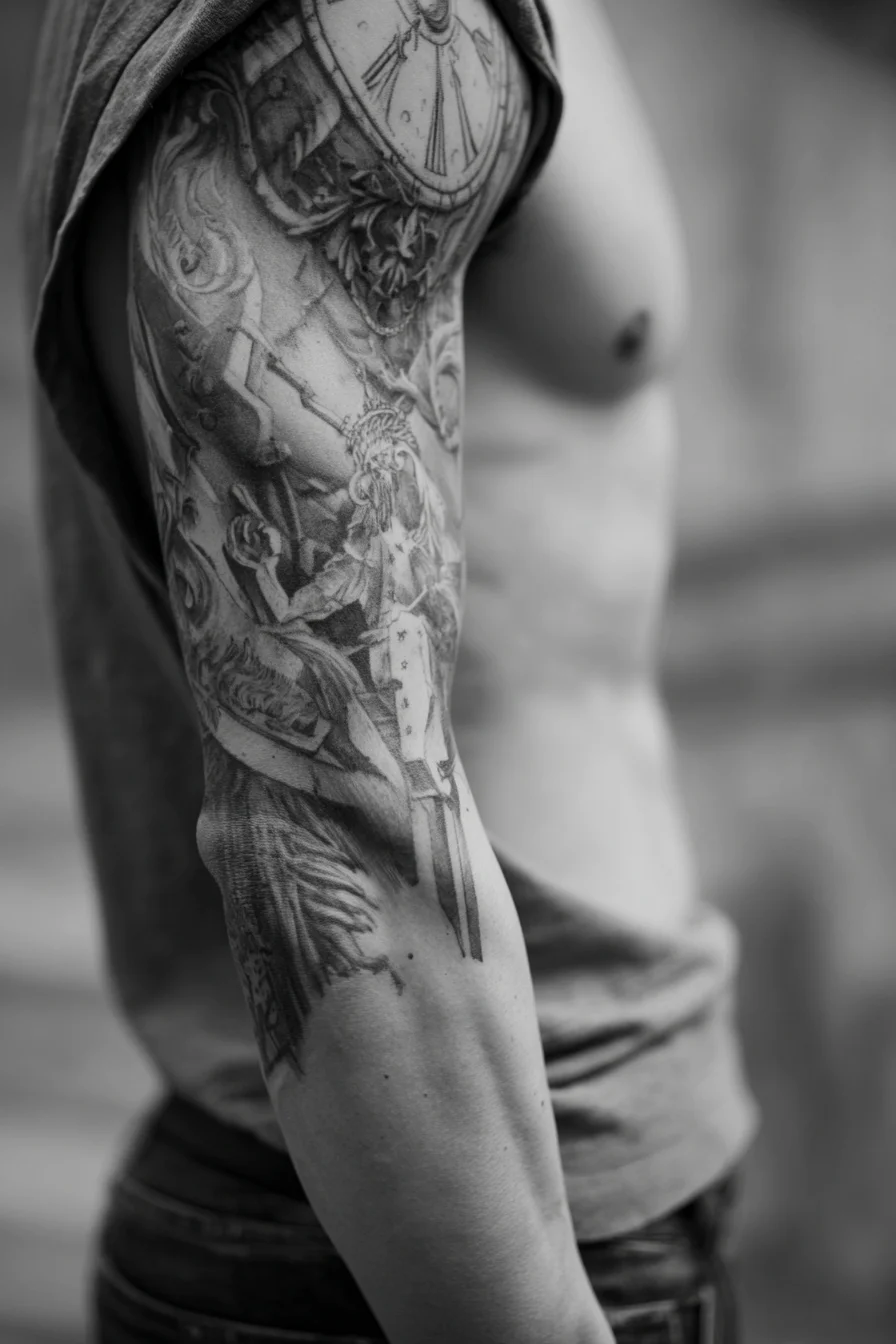
This black-and-grey realism sleeve blends a detailed pocket watch, a classical robed figure (evoking sacrifice, time and introspection) and a dagger — symbols that read as mortality, personal struggle and resilience. For men who want a strong narrative piece, it works well as a full or half sleeve that wraps the upper arm, extends onto the shoulder and can flow down to the forearm or chest for continuity. Placement suggestions: outer upper arm and shoulder are ideal for showcasing detail and are lower-pain areas; extending toward the inner bicep, elbow crease or wrist increases visibility but raises discomfort. Expect moderate pain overall — outer arm sessions are tolerable, while inner arm, elbow and wrist work can be more intense. Size considerations: keep the composition medium-to-large to preserve fine shading and clock face detail; too small will lose subtleties. Styling variations: stick with pure black-and-grey for a classic look, add selective color accents (bronze tones on the watch or red on the dagger), or incorporate dotwork, geometric framing or negative space to modernize the piece. Consult an experienced realism artist for session planning, layered shading and aftercare to ensure crisp long-term results.
Greek Warrior Helmet Tattoo — Blackwork Spartan/Ancient Warrior Arm Piece
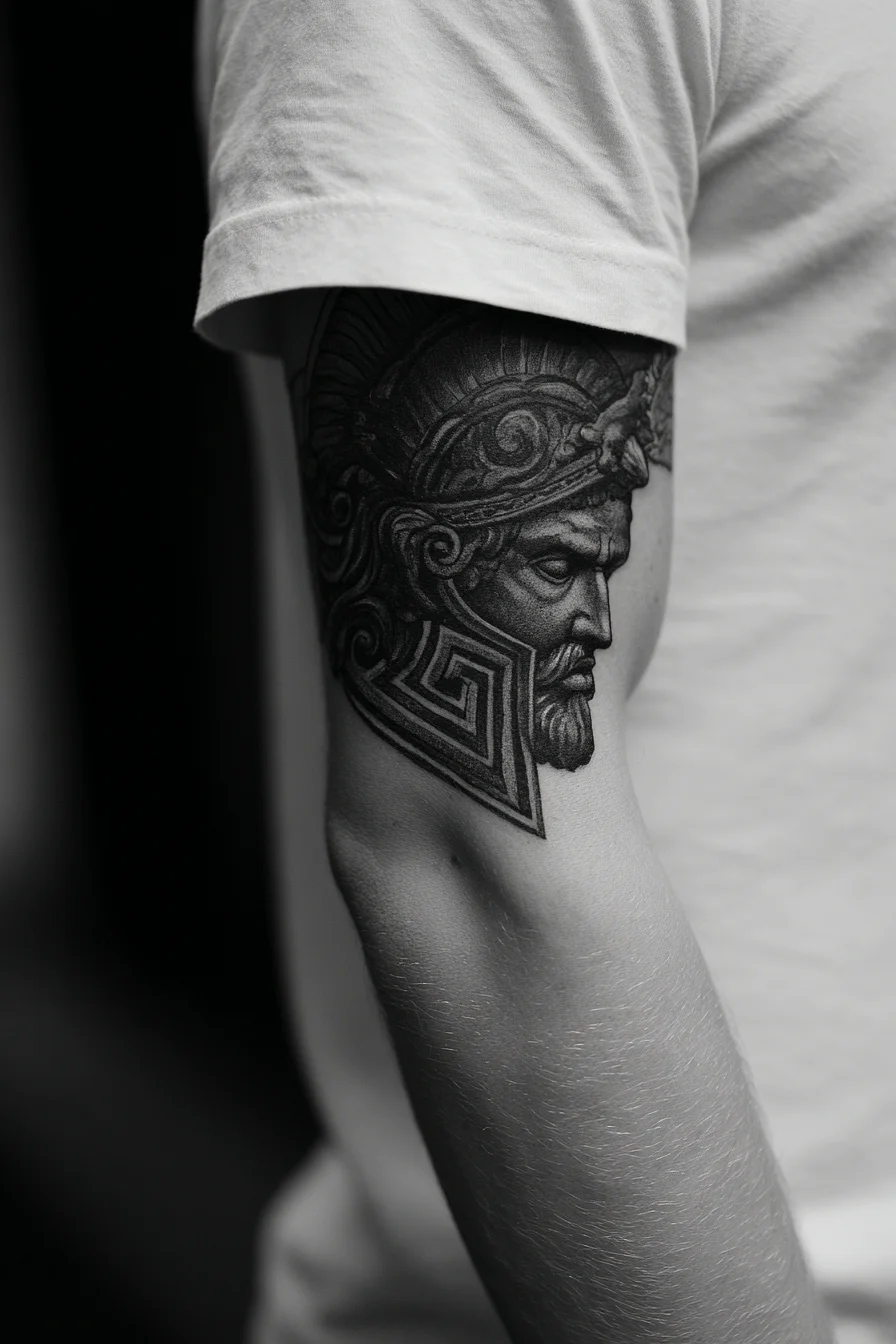
This bold Greek warrior helmet tattoo reads as strength, discipline, and classical heritage. The helmeted profile evokes stoicism and protection, making it a popular choice for men who want a masculine, iconic motif that pairs well with sleeve work or standalone upper-arm pieces. Placement suggestions: outer upper arm (as shown) for lower pain and easy concealment, shoulder-to-chest wraps for a heroic chest piece, or forearm/calf if you want daily visibility. Pain expectations: outer upper arm and shoulder are generally low-to-moderate; inner arm, ribs, and bony areas are noticeably more painful. Expect multiple sessions if you opt for heavy shading or large scale. Size considerations: keep this design medium-to-large (roughly 4–8 inches / 10–20 cm) to preserve facial detail and helmet ornamentation; smaller sizes may lose fine shading. Styling variations: pure blackwork or dotwork for a timeless look, photorealistic shading for a portrait feel, neo-traditional linework with color accents (deep reds, golds), or geometric Greek-key backgrounds to emphasize form. Consult a skilled portrait/shading artist to retain contrast and depth over time.
Leopard Portrait Forearm Tattoo — Watercolor Realism
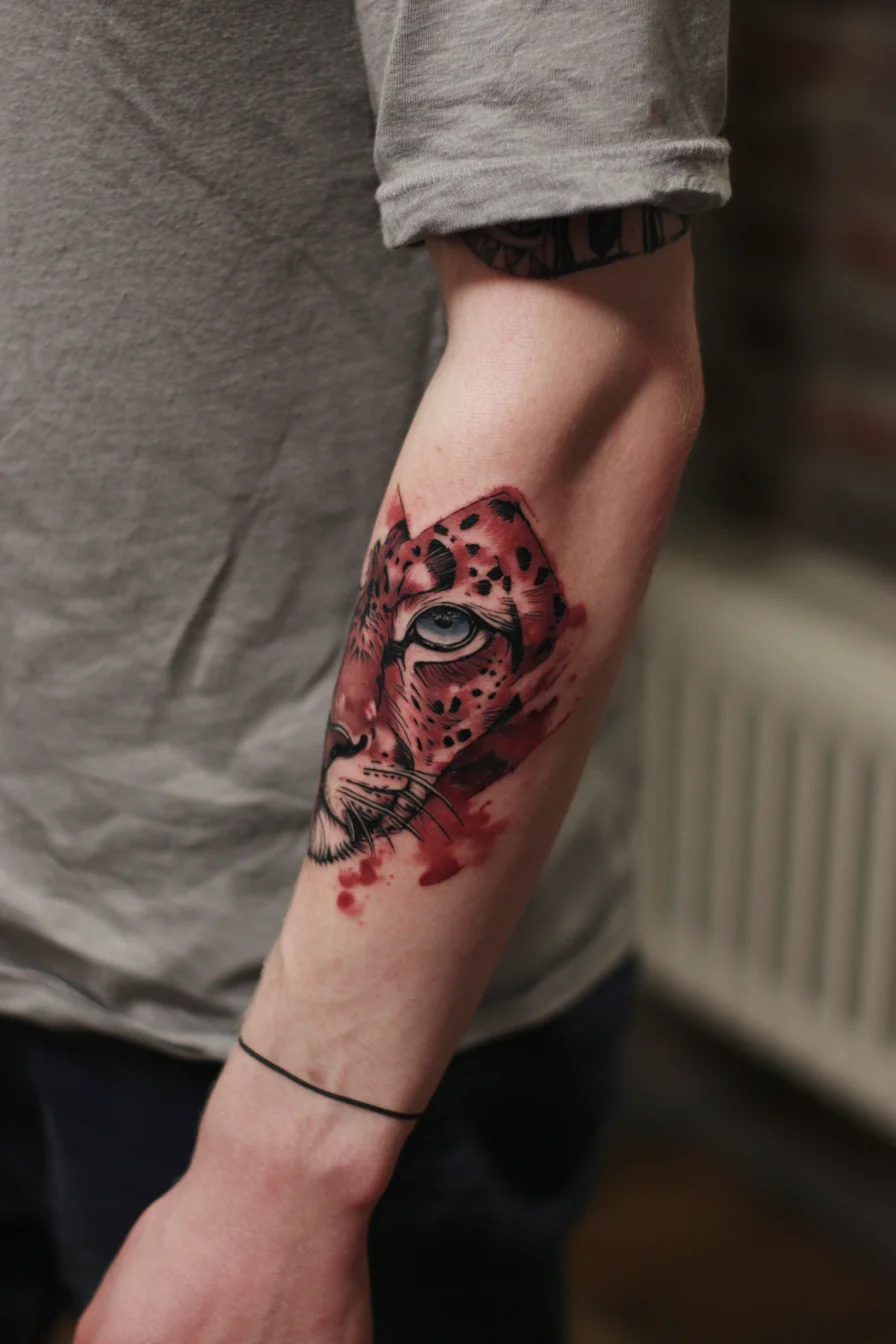
This striking half-leopard portrait merges realistic linework with loose watercolor splashes, symbolizing strength, focus and quiet intensity — qualities many men choose to express through animal imagery. Ideal on the inner forearm, the placement gives strong visibility for personal expression while remaining easy to conceal with long sleeves. Pain is generally moderate on the forearm: fleshier mid-forearm areas tolerate work well, while the wrist, elbow crease and bony edges are more sensitive. For detail retention choose a medium-sized piece (about 4–8 inches / 10–20 cm) so the eye, spots and whisker lines stay crisp; larger canvases allow greater realism and smoother color transitions. Styling variations include full-color watercolor washes, black-and-gray realism for a subtler look, dotwork texture, geometric framing or integration into a sleeve or chest piece. Practical advice: saturated color and confident outlines age better, and multi-session bookings improve depth. Before booking, review portfolios for artists experienced in both portrait realism and watercolor techniques and follow aftercare instructions closely to protect healing and long-term appearance.
Classical Statue Portrait — Black & Grey Upper Arm / Half-Sleeve Tattoo
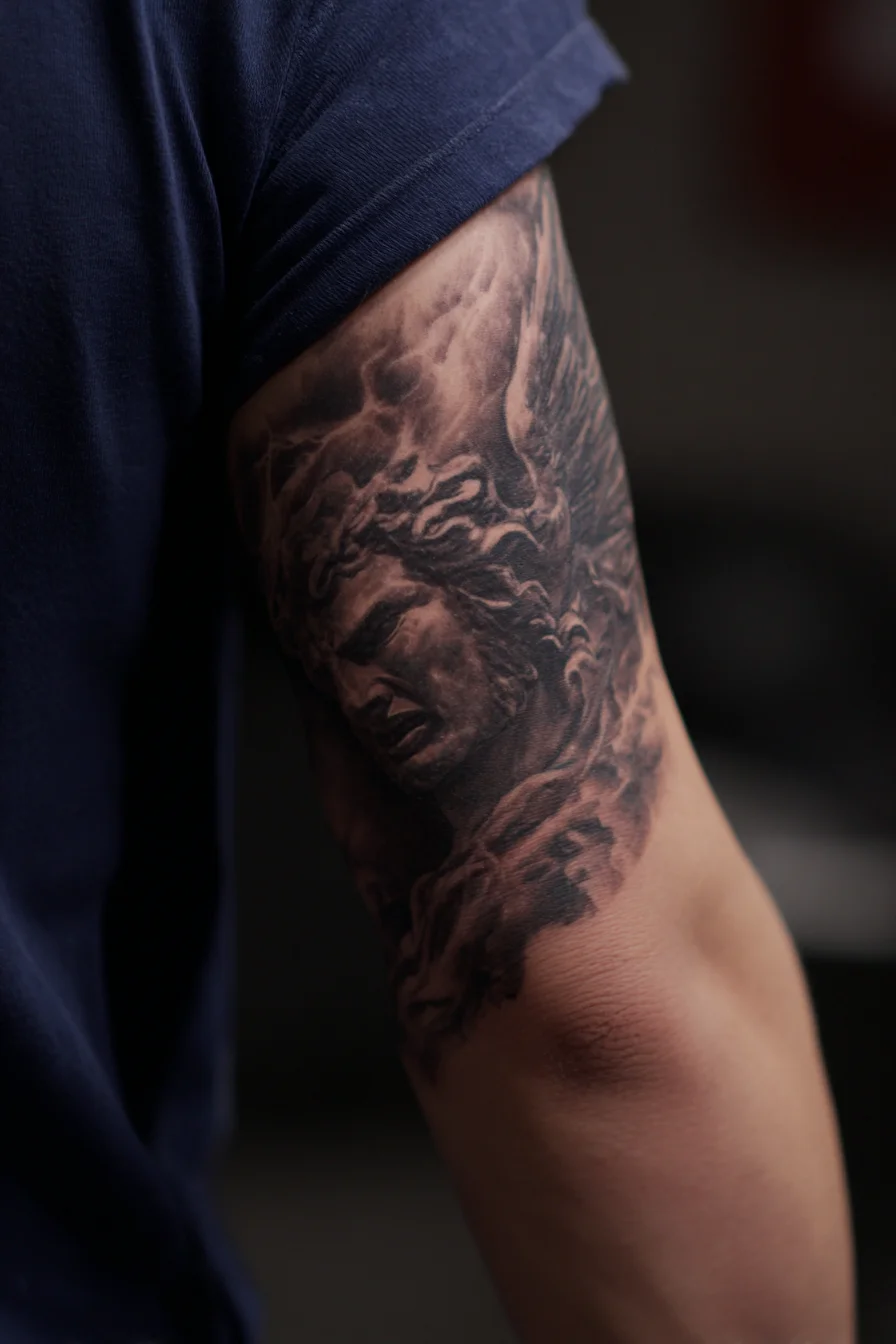
This black-and-grey classical statue portrait evokes timeless strength, stoicism, and masculine elegance. As a design it leans into realism and sculptural form — ideal for clients who want a bold, narrative piece that reads as both art and emblem. Placement suggestions include the outer or back of the upper arm, wrapping into a half-sleeve or finishing just above the elbow; the bicep/tricep canvas lets the face sit naturally with flowy background shading. Pain expectations are moderate: the fleshy outer bicep is among the more comfortable areas, while edges near the inner arm, elbow, or bone will be noticeably more sensitive; plan sessions accordingly. For detail retention, aim for a minimum of 4–6 inches in height for a single-face piece; larger half- or full-sleeves allow more texture, background elements, and contrast without losing fine features. Styling variations include high-contrast black-and-grey realism (as shown), soft dotwork/greywash backgrounds, subtle color accents (sepia or muted blue), or integration with geometric frames, wings, or script for personal symbolism. Discuss session length and touch-up strategy with your artist to ensure long-term clarity.
Geometric Arrow Compass Tattoo — Forearm Directional Blackwork Design
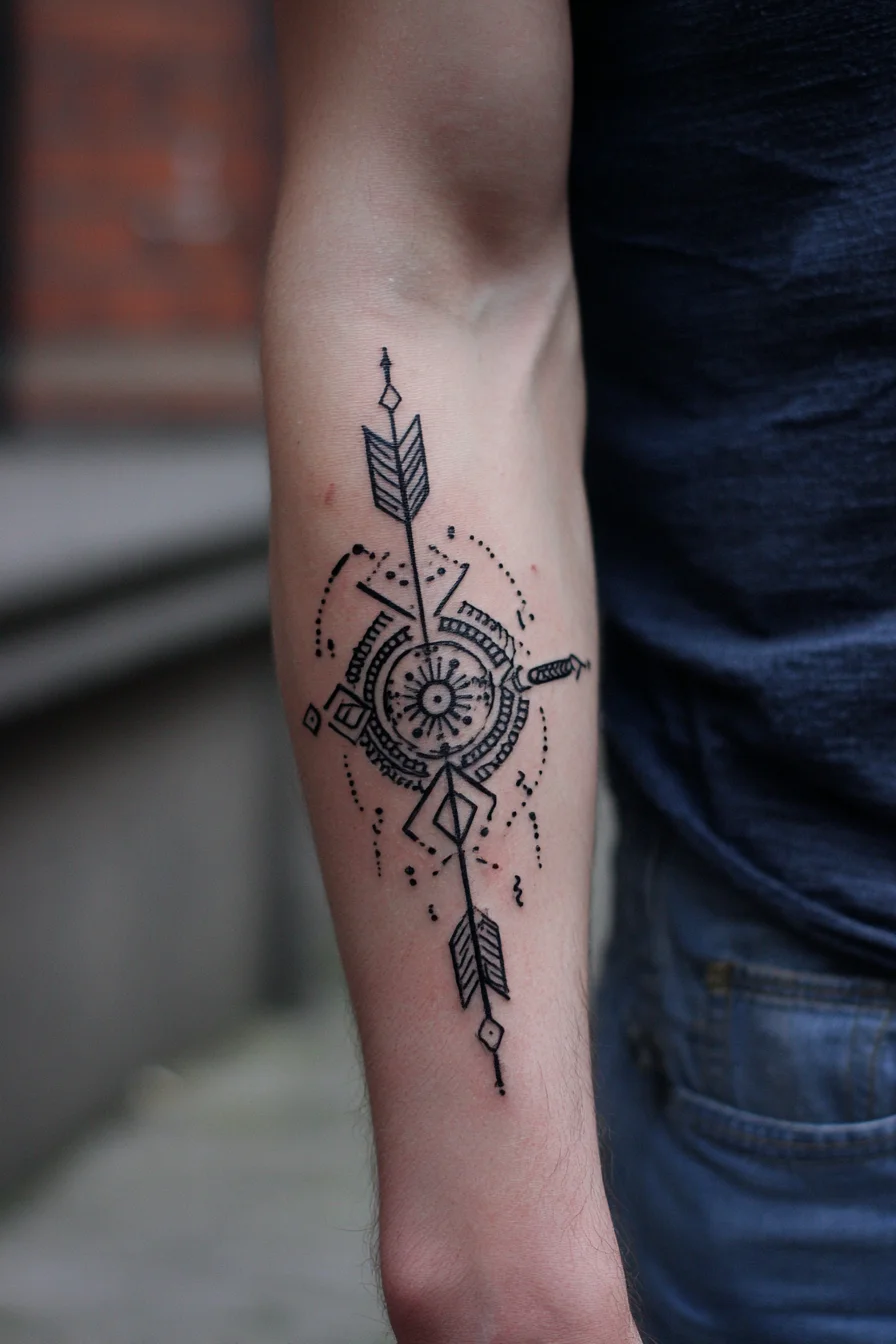
This design blends a vertical arrow with a circular compass/mandala center, symbolizing direction, purpose, protection and inner focus — ideal for men who want a modern, meaningful piece. For placement, the inner forearm (as shown) emphasizes the long, vertical composition and offers a balance of visibility and concealability; alternatives include the outer forearm, along the ribcage, down the calf or centered on the chest for a more dramatic scale. Expect pain to be low-to-moderate on the forearm: the soft inner forearm near the wrist and elbow can be more sensitive, while the outer forearm is one of the more comfortable spots. Size considerations: a medium, elongated layout (about 10–15 cm / 4–6 in) preserves the geometric detail; scale up to 20+ cm if you want finer radial detail on the chest or back. Styling variations: keep it crisp blackwork with bold outlines and dotwork for longevity, or add subtle shaded fills, earth-tone inks, or watercolor accents for personality. Work with a linework/geometrics specialist to ensure symmetry and long-term clarity.
Realistic Eye with Roman Clock Tattoo — Forearm/Upper-Arm Timepiece
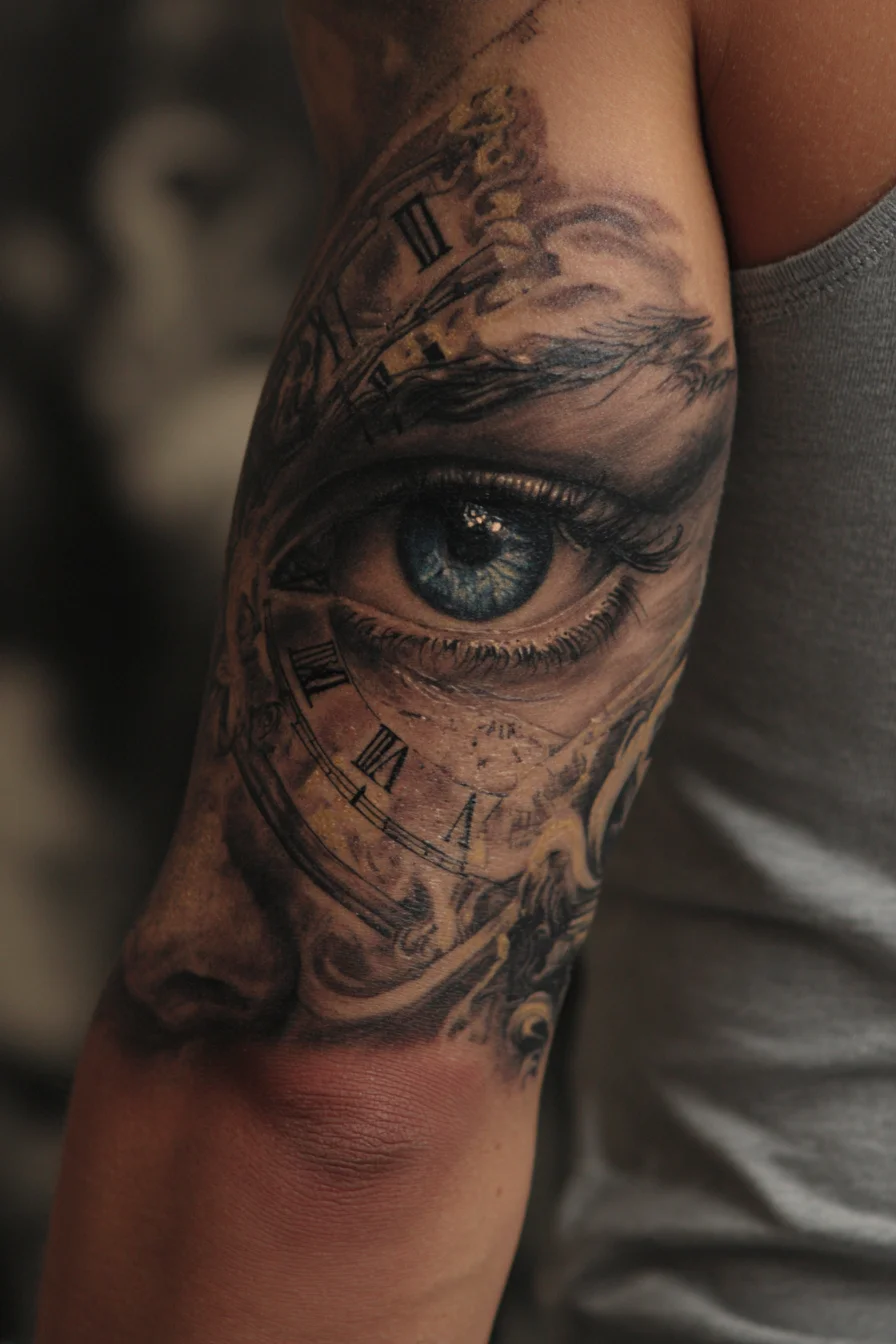
This hyperrealistic eye combined with a Roman-numeral clock blends vigilance, memory and the passage of time into a visually striking narrative. It reads as a reminder to watch over what matters and acknowledges mortality and personal history. Placement suggestions for men: outer forearm or upper arm for visibility and lower pain; inner bicep or half-sleeve wrap if you want a more intimate, sculpted look; integrating the design around the elbow gives dynamism but increases discomfort. Pain expectations: outer forearm is low-to-moderate, inner arm and over the elbow are significantly more sensitive — expect multiple shorter sessions for comfort. Size considerations: the eye’s fine details need scale — aim for at least palm-sized (8–12 cm) or a half-sleeve to retain iris texture and clock markings; small versions will blur over time. Styling variations: full-color hyperrealism to highlight a blue iris, classic black-and-grey realism for longevity, baroque filigree to emphasize the clock, or subtle watercolor accents for contrast. Discuss contrast, line weight and placement with your artist to match musculature and skin tone, and plan aftercare and staged sessions.
Hannya (Oni) Mask Tattoo — Japanese Demon Black & Grey Upper-Arm Design
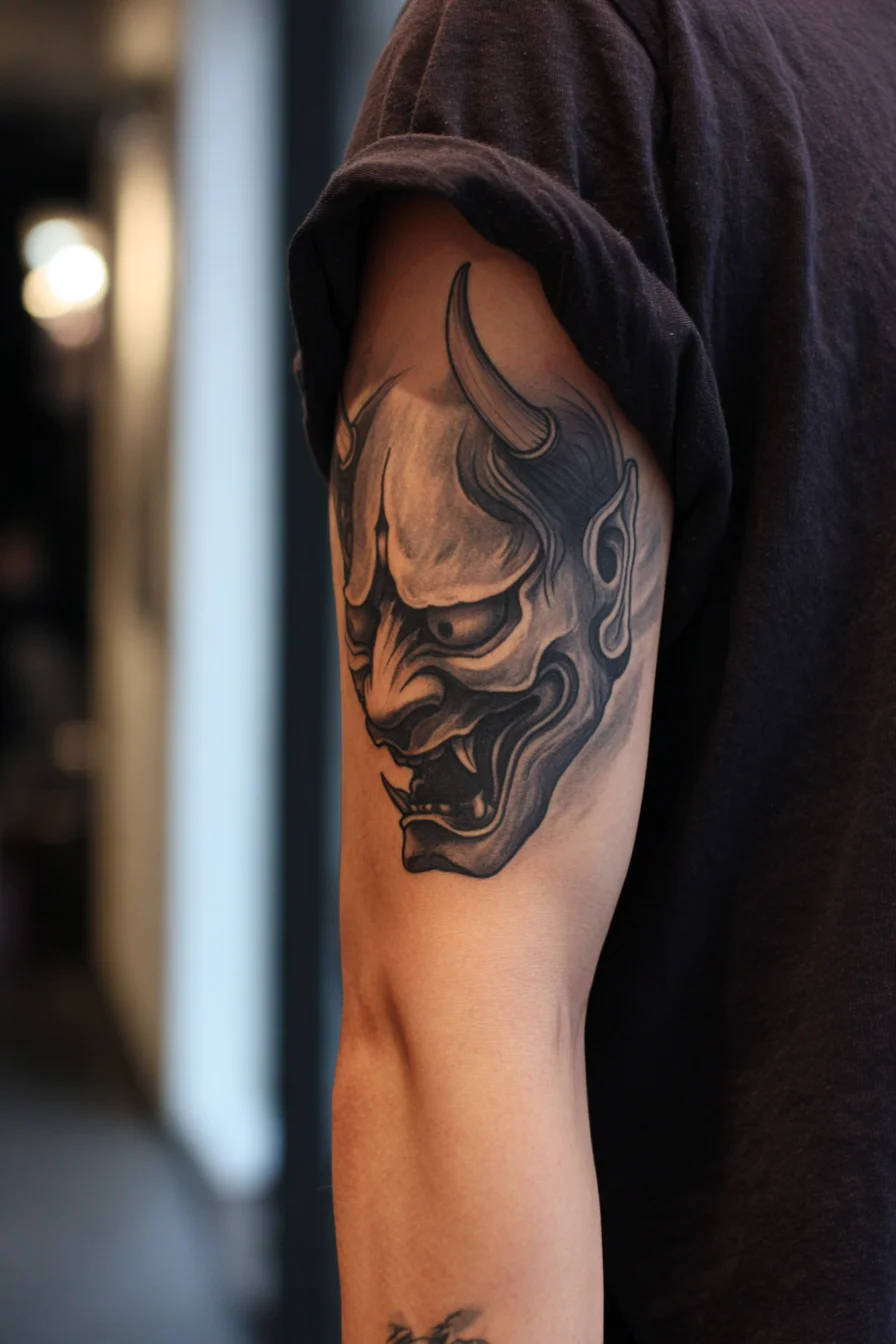
This Hannya/Oni mask is a bold piece rooted in Japanese folklore, representing the duality of anger and protection—emotions, betrayal, and transformative strength. Rendered in black and grey shading, it emphasizes depth, expression and dramatic contrast, making it a strong choice for men who want a masculine, narrative-focused tattoo. Placement suggestions: outer bicep or upper arm for moderate visibility and lower pain, inner bicep or chest for a more intimate, striking effect; it also adapts well to a half-sleeve wrap or calf placement. Pain expectations: outer bicep is generally low-to-moderate pain; inner arm, armpit-adjacent areas, and near bone (elbow, ribs) increase discomfort. Size considerations: keep this design at medium-to-large scale (roughly 5–10 inches / 12–25 cm) to preserve facial detail and shading; very small reductions will lose expression. Styling variations: full black-and-grey realism, bold neo-traditional linework, or adding color highlights (deep reds/indigos) for intensity; backgrounds like smoke, waves, or florals (peony/chrysanthemum) can contextualize the mask. Consult a tattooist experienced in Japanese motifs to adapt line flow to muscle contours and ensure longevity and proper aftercare.
Inner bicep tattoos are rewarding but demand thoughtful planning. From my years of consulting I always recommend choosing an artist who understands arm anatomy and provides healed photos. Confirm exact stencil placement both relaxed and flexed so the design reads correctly in motion. During the session, take breaks, stay hydrated, and communicate discomfort early. For healing: keep the area clean, use recommended ointments sparingly, avoid tight sleeves and heavy lifting for the first two weeks, and protect freshly healed skin from sun exposure. Expect some fading in friction-prone spots and schedule a touch-up at 8–12 weeks if needed. Use the 28-image gallery as inspiration, then personalize elements to your story and body shape. If you want help refining a concept or choosing an artist, I’ll guide placement, sizing, and aftercare tailored to your lifestyle. — Hakan
